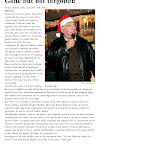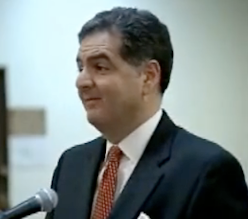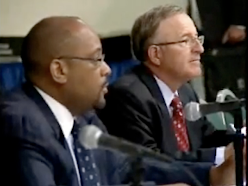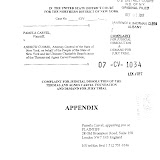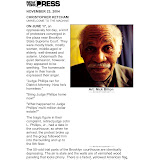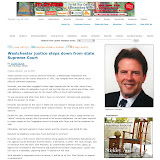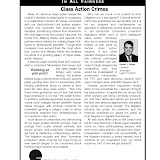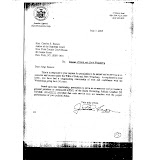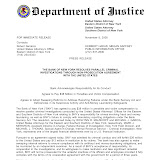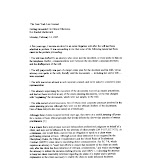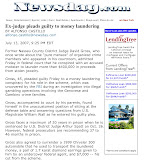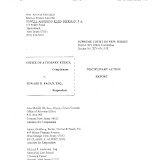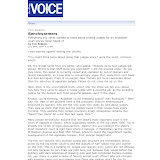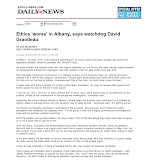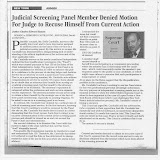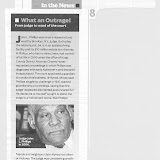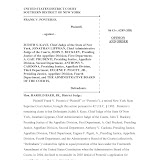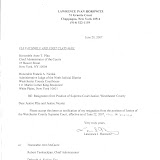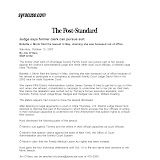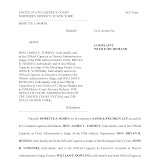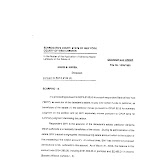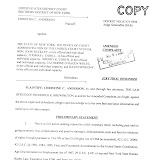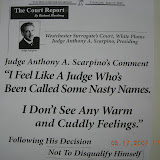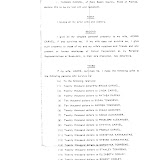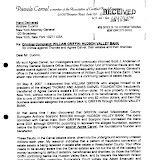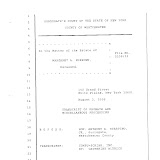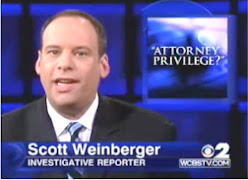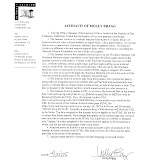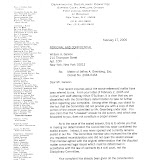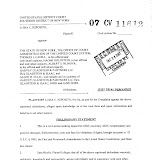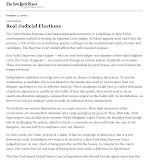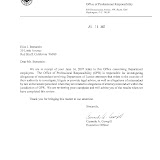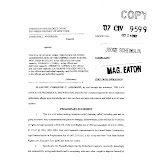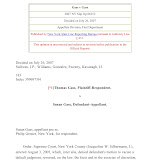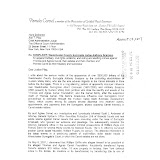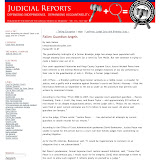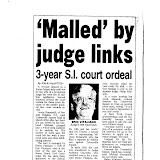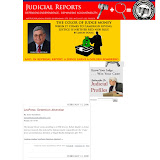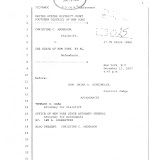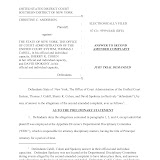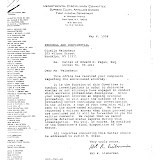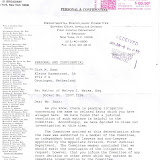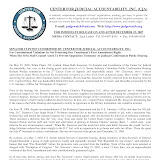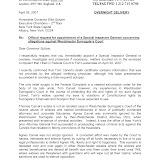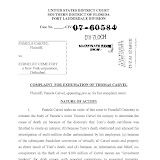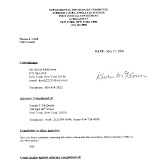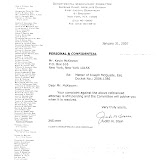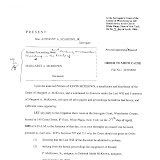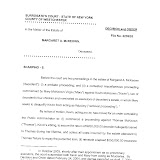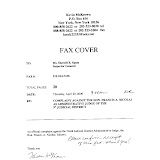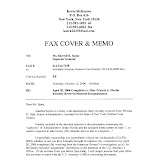N. Georgia judge investigated for brandishing gun in court
The Atlanta Journal-Constitution by Bill Rankin - February 25, 2012
A North Georgia judge is being investigated for pulling out a handgun during a hearing this week as a woman testified about being an assault victim. Lumpkin County Superior Court Judge David E. Barrett pulled out his pistol Wednesday not in anger, but out of frustration and to make "a poor rhetorical point," District Attorney Jeff Langley said Saturday. Langley, who was in the courtroom when it happened, said the Judicial Qualifications Commission has launched an investigation of the judge. "It was totally inappropriate conduct for a courtroom," Langley said. The district attorney said that he approached the bench after Barrett pulled out his gun and told the judge to put his pistol away. The judge did so and the hearing continued, Langley said. Barrett, chief judge of the Enotah Judicial Circuit, did not immediately respond to emails or to phone calls left at his office Saturday. Under Georgia law, judges are allowed to carry a concealed weapon on the bench, but it is a crime to point a pistol at another person when there is no justification to do so. Jeff Davis, director of the Judicial Qualifications Commission, said Saturday he could neither confirm nor deny whether the judicial watchdog agency was investigating Barrett. The bizarre conduct occurred Wednesday during a bond hearing and a request for a temporary protective order against Scott Sugarman, a former Hall County sheriff's deputy who was recently arrested on a number of charges, including rape and aggravated assault with a handgun. Sugarman has pleaded not guilty. The woman who filed the charges against Sugarman was on the witness stand and had testified Sugarman had abused her and, on one occasion, had put a gun to her head. During the latter part of her testimony, the woman was not being cooperative, Langley said. Barrett told the woman she was "killing her case" and pulled out his gun and, feigning to offer it to her, said, "You might as well shoot your lawyer," Langley said. At that point, Langley said, he approached the bench and told the judge to put the gun away. The woman's lawyer, Andrea Conarro of Dahlonega, on Saturday described the scene, as Barrett swept the pistol across the courtroom, "as one of those slow motion kind of events." "Later, as it sunk in, I was upset, and I felt like a tragedy had been created," she said, adding that by "tragedy" she meant what could happen to Barrett because of what he did. Both Conarro and Langley said the woman, whose name is being withheld because The Atlanta Journal-Constitution does not disclose the names of victims of alleged sexual assault, did not appear to be traumatized. "My client thought it was a test, that he was trying to see how she would respond, like it was a credibility determination," Conarro said. Said Langley, "When it happened, I objected and sought to take control of the situation and terminate that conduct immediately."
-----RELATED STORY:
Georgia Judge Accused of Pulling a Gun in Court
NBC-DFW by Tierney McAfee - February 28, 2012
A North Georgia judge is being investigated after pulling out a handgun in court to prove a point while a witness was testifying in a rape case,The Atlanta Journal-Constitution reported. Superior Court Judge David Barrett told the witness that she might as well shoot her lawyer because she was “killing her case.” He pretended to offer her his handgun before prosecutor Jeff Langley told the judge the move was inappropriate and asked him to put away the weapon. “When it happened, I objected and sought to take control of the situation and terminate that conduct immediately,” Langley told the Atlanta paper. The female victim, who had accused a Sheriff’s deputy of rape and aggravated assault with a handgun, was not being cooperative during the latter part of her testimony, Langley said. That's when the judge pulled out his pistol. The woman's lawyer, Andrea Conarro, called the moment “one of those slow motion kind of events.” “Later, as it sunk in, I was upset, and I felt like a tragedy had been created,” she said. Under Georgia law, judges are permitted to carry concealed weapons in a courtroom but they are not allowed to point a gun at another person without just cause. The Judicial Qualifications Commission has launched a probe into the incident but Judge Barrett has not faced any criminal charges, according to Langley.
-----RELATED STORY:
Judge Pulls Gun In Courtroom: David Barrett Under Investigation In North Georgia
The Huffington Post by Andy Campbell - February 28, 2012
Some judges pack a gavel -- this judge was packing heat.
A Georgia judge is under fire after he allegedly pulled his pistol in a courtroom in an apparent attempt to drive a point home to a sexual assault victim. Lumpkin County Superior Court Judge David Barrett wasn't angry, but making "a poor rhetorical point" when he flashed the piece this week, District Attorney Jeff Langley told the Atlanta Journal-Constitution. Barrett was presiding over a sexual assault case in which a woman brought charges of rape and aggravated assault against Scott Sugarman, a former Hall County sheriff's deputy. But when the victim took the stand to testify, Barrett told her that she was "killing her case" -- allegedly because she wasn't cooperating -- pulled out his gat and pretended to hand it her way. "[Barrett said] 'You might as well shoot your lawyer,'" Langley told the paper. The woman -- whose name is being withheld because she may be the victim of a sexual crime -- wasn't shocked and "thought it was a test" by Barrett to gauge her reaction. Langley claims that he objected and approached the bench to tell Barrett to put the gun down. Now Barrett is under investigation by the state Judicial Qualifications Commission, which probes judge misconduct, the Associated Press reported. Georgia law allows judges to carry concealed handguns in the courtroom, but it's a crime to point a gun at another person if there's no reason to do so.
MLK said: "Injustice Anywhere is a Threat to Justice Everywhere"
End Corruption in the Courts!
Court employee, judge or citizen - Report Corruption in any Court Today !! As of June 15, 2016, we've received over 142,500 tips...KEEP THEM COMING !! Email: CorruptCourts@gmail.com
Most Read Stories
- Tembeckjian's Corrupt Judicial 'Ethics' Commission Out of Control
- As NY Judges' Pay Fiasco Grows, Judicial 'Ethics' Chief Enjoys Public-Paid Perks
- New York Judges Disgraced Again
- Wall Street Journal: When our Trusted Officials Lie
- Massive Attorney Conflict in Madoff Scam
- FBI Probes Threats on Federal Witnesses in New York Ethics Scandal
- Federal Judge: "But you destroyed the faith of the people in their government."
- Attorney Gives New Meaning to Oral Argument
- Wannabe Judge Attorney Writes About Ethical Dilemmas SHE Failed to Report
- 3 Judges Covered Crony's 9/11 Donation Fraud
- Former NY State Chief Court Clerk Sues Judges in Federal Court
- Concealing the Truth at the Attorney Ethics Committee
- NY Ethics Scandal Tied to International Espionage Scheme
- Westchester Surrogate's Court's Dastardly Deeds
Wednesday, February 29, 2012
Judge Accused of Pulling a Gun in Court
Wanted: Judicial Appointments of Those with Courage to Fight Corruption
Appointments Could Be Close to Fill Appellate Vacancies
The New Law Journal by John Caher - February 29, 2012
ALBANY, NY - Fourteen months into his administration, Governor Andrew M. Cuomo has yet to appoint a judge to the Appellate Division, as the number of vacancies has increased to 10. Mr. Cuomo could also appoint two justices to presiding justice posts.
Vacancies exist in all four Appellate Division departments, and two departments—the Second in Brooklyn and Third in Albany—are operating with acting presiding justices. Although some of the vacancies are relatively new, others have existed for well over a year.
Sources close to the administration said nominations are imminent and a batch of appointments will likely be made by mid-March. They said the holdup has been the somewhat unwieldy screening panel process and extensive vetting by both the panels and the governor's counsel office.
Thirteen-member screening committees were established by executive order within a few months of Mr. Cuomo taking office, and the governor promptly made his five appointments to each of the panels.
Remaining appointments by legislative leaders, the chief judge, the attorney general and the New York State Bar Association trickled in. "Setting up the committees took a lot longer than anyone thought," said a person with knowledge of the situation. "The committees were a cumbersome and clunky process the first time through. The process is designed to get quality candidates with a wide variety of input, but it is not a system designed for efficiency and speed. That really is the big problem." Meanwhile, all four Appellate Division departments are shorthanded. "Obviously, it is more work," said Presiding Justice Henry J. Scudder of the Fourth Department, whose court is short three of the 12 judgeships, or 25 percent. One of the vacancies was created less than a month ago when Justice Jerome C. Gorski retired. Another position has been vacant since Justice Samuel L. Green retired at the end of 2011. But the third position has been vacant since the December 2010 retirement of Justice Elizabeth W. Pine. "The judges sit more days and they do more work," Justice Scudder said. "We are trying to get our cases out the door in a timely fashion and it is harder. The governor has a lot on his plate and we are not criticizing the governor at all, but it would be much more efficient for the court to have a full amount of judges." In the Second Department, Justice William F. Master has served as acting presiding justice since A. Gail Prudenti became chief administrative judge on Dec. 1. In addition, vacancies created by the 2010 retirement of Justice Fred T. Santucci and September 2011 departure of Justice Joseph Covello remain. Further, the 22nd judgeship on the Second Department bench has never been filled and is available for Mr. Cuomo to make an appointment.
'Judges Have Stepped Up'
Sources said more than a dozen judges have applied for the Second Department presiding judgeship, but interviews have not yet been completed. Aprilanne Agostino, the longtime Second Department clerk, said the vacancies have not affected case flow, but "only because the judges have stepped up." "They are working that much harder," Ms. Agostino said. "We are producing the same amount of work because they are scheduled [to hear appeals] more frequently. We are asking them to do a lot. It is a tough time right now." Ms. Agostino said she has seen lengthy delays before in the appointment of justices and is not surprised that a new governor seems to be taking his time. "It is a very important decision to make and he [Mr. Cuomo] is new to making those type of decisions," Ms. Agostino said. "I have seen delays of this length before." The First Department in Manhattan is down three of its 20 judges. Two of the vacancies—those created by the retirements of Justices John T. Buckley and Eugene Nardelli—date to the end of 2010. The third position opened last spring when Justice James M. McGuire returned to private practice. "The judges find themselves with more of a workload, which they are handling because they are all great sports," said Susan Hernandez Roura, assistant to Presiding Justice Luis Gonzalez. "I know there are some budgetary concerns, but I hope they do fill the positions soon." Susanna Molina Rojas, the First Department clerk, confirmed that the workload has increased considerably. "If you have less staff and the same number of cases, of course it increases the workload," Ms. Rojas said. However, she said that while 2011 case management statistics are not yet available, she does not believe the shortage of judges has delayed decisions. Ms. Rojas said the First Department has been given no indication of when the positions will be filled. "I know that interviews were conducted by the governor because it was posted by the Law Journal, but we have no idea," she said. "We are hoping sooner rather than later." In the Third Department in Albany, Thomas E. Mercure has served as acting presiding justice for the past year, after Presiding Justice Anthony V. Cardona was diagnosed with cancer. Justice Cardona died in early December, creating the only vacancy on that court. When fully staffed, the Third Department has 12 judges. Steven M. Cohen, a former top advisor to the governor who is now a partner in the Manhattan office of Zuckerman Spaeder, said the delay in appointments is indicative of a meticulous screening process. "My experience is that when the emphasis is on quality there is a tendency for the process to take longer," Mr. Cohen said. "At the end of the day, what you want is a high quality judiciary, and that is what you are going to get." Another person familiar with the process said Mr. Cuomo is viewing the dozen pending Appellate Division appointments "as a chessboard," with a goal of ensuring overall diversity. That is especially true with regard to the presiding judgeships since those judges, along with Chief Judge Jonathan Lippman, form the administrative board of the courts and direct many court operations. "It makes sense to think of it holistically and you don't want someone with the same background in all of the positions, where if you do it piecemeal that could happen," the source said. Appellate Division justices are selected by the governor from the ranks of elected Supreme Court justices; acting Supreme Court justices are not eligible. The governor must choose from among the candidates found qualified by the screening panels. Although Mr. Cuomo has not named any Appellate Division justices, he has reappointed some judges who were appointed by prior governors. For instance, he recently reappointed Justices Edward O. Spain and John A. Lahtinen in the Third Department. John Caher can be contacted at jcaher@alm.com.
Tuesday, February 28, 2012
New NY Strategy: Wait Unit Judge Retires to Criticize
Judge Criticized for Issuing Contradictory Rulings
The New York Law Journal by John Caher - February 28, 2012
ALBANY, NY - A recently retired Family Court judge's practice of ordering "inherently contradictory" child placements calling for both permanent adoption and reunification with the family has resulted in a rebuke from a state appeals panel. The Appellate Division, Third Department, said in a decision Feb. 16 that St. Lawrence County Family Court Judge Barbara R. Potter, who retired at the end of 2011, has ordered concurrent permanency goals at least three times since 2009. "Petitioner cannot reasonably work toward the goal of placing the child for adoption—which, pursuant to the statute, requires petitioner to file a petition to terminate respondent's parental rights—while at the same time trying to return the child to his parents," Judge William E. McCarthy wrote for the unanimous court in Matter of Dakota F., 511718. In the latest case, Dakota F., a neglected child born in 2003, was removed to the custody of St. Lawrence County Department of Social Services with the goal of eventually returning her to her mother. However, in September 2009, the social services agency sought to change the recommendation to placement for adoption. After a hearing, and without consulting with the child, Judge Potter issued an order calling for a "concurrent plan of return to parent and placement for adoption." The Third Department held that Judge Potter "erred by not consulting with the child in any manner, or even eliciting an opinion of the child's wishes from the attorney for the child." But the panel said there was no need to determine if that error required reversal, since reversal "is necessary due to a more fundamental error"—the contradictory order. Justice McCarthy observed that under Family Court Act Article 10-A, judges have a number of alternatives in ordering permanency goals, ranging from return to the parent to placement with a relative to placement for adoption. But the judge must select one. He indicated that Judge Potter had a tendency to choose more than one, referring to Matter of A.D., 27 Misc 3d 1229 (2010), and Matter of Andrea D., 25 Misc 3d 503 (2009). "Because the court did not consult with the child and imposed concurrent—and inherently contradictory—permanency goals rather than a single permanency goal, we must remit for further proceedings," Justice McCarthy wrote. Acting Presiding Justice Thomas E. Mercure (See Profile) and Justices Robert S. Rose, Edward O. Spain and Bernard J. Malone Jr. also were on the panel. John A. Cirando of Syracuse represented the mother seeking custody. "Hopefully, this decision will clarify the procedures going forward and give children a good chance to be reunited with their parents," Mr. Cirando said. Laurie L. Paro of Canton appeared for the Department of Social Services and Aaron Turetsky of Keeseville argued for the child. Neither Ms. Paro nor Mr. Turetsky were available for comment. Former Judge Potter also was unavailable. John Caher can be contacted at jcaher@alm.com.
The New York Law Journal by John Caher - February 28, 2012
ALBANY, NY - A recently retired Family Court judge's practice of ordering "inherently contradictory" child placements calling for both permanent adoption and reunification with the family has resulted in a rebuke from a state appeals panel. The Appellate Division, Third Department, said in a decision Feb. 16 that St. Lawrence County Family Court Judge Barbara R. Potter, who retired at the end of 2011, has ordered concurrent permanency goals at least three times since 2009. "Petitioner cannot reasonably work toward the goal of placing the child for adoption—which, pursuant to the statute, requires petitioner to file a petition to terminate respondent's parental rights—while at the same time trying to return the child to his parents," Judge William E. McCarthy wrote for the unanimous court in Matter of Dakota F., 511718. In the latest case, Dakota F., a neglected child born in 2003, was removed to the custody of St. Lawrence County Department of Social Services with the goal of eventually returning her to her mother. However, in September 2009, the social services agency sought to change the recommendation to placement for adoption. After a hearing, and without consulting with the child, Judge Potter issued an order calling for a "concurrent plan of return to parent and placement for adoption." The Third Department held that Judge Potter "erred by not consulting with the child in any manner, or even eliciting an opinion of the child's wishes from the attorney for the child." But the panel said there was no need to determine if that error required reversal, since reversal "is necessary due to a more fundamental error"—the contradictory order. Justice McCarthy observed that under Family Court Act Article 10-A, judges have a number of alternatives in ordering permanency goals, ranging from return to the parent to placement with a relative to placement for adoption. But the judge must select one. He indicated that Judge Potter had a tendency to choose more than one, referring to Matter of A.D., 27 Misc 3d 1229 (2010), and Matter of Andrea D., 25 Misc 3d 503 (2009). "Because the court did not consult with the child and imposed concurrent—and inherently contradictory—permanency goals rather than a single permanency goal, we must remit for further proceedings," Justice McCarthy wrote. Acting Presiding Justice Thomas E. Mercure (See Profile) and Justices Robert S. Rose, Edward O. Spain and Bernard J. Malone Jr. also were on the panel. John A. Cirando of Syracuse represented the mother seeking custody. "Hopefully, this decision will clarify the procedures going forward and give children a good chance to be reunited with their parents," Mr. Cirando said. Laurie L. Paro of Canton appeared for the Department of Social Services and Aaron Turetsky of Keeseville argued for the child. Neither Ms. Paro nor Mr. Turetsky were available for comment. Former Judge Potter also was unavailable. John Caher can be contacted at jcaher@alm.com.
Judge, "A Disgrace to His Oath as a Prosecutor and a Lawyer"
Bruno Mars’ former prosecutor sentenced to nine months in jail for felony crack possession
The Assocaited Press - Februry 27, 2012
Former Deputy District Attorney David Schubert apologized for what he called 'a tragedy'
LAS VEGAS, NV — A former top Las Vegas drug prosecutor who handled the high-profile Paris Hilton and Bruno Mars cocaine possession plea deals was sentenced Monday to nine months in county jail in a felony crack possession case. Former Deputy District Attorney David Schubert apologized to the court for what he called “a tragedy,” and then stood silently as a state court judge berated him as “a disgrace to his oath as a prosecutor and a lawyer.” Clark County District Court Judge Carolyn Ellsworth also said that the terms of a plea deal that could have gotten Schubert just probation and a chance to clear his record were “offensive.” “I’m not going to give you the special treatment,” the judge said. Police arrested Schubert last March after they watched another man get out of Schubert’s car, go into an apartment complex and return. Officers found Schubert with a $40 rock of crack cocaine and confiscated an unregistered 9mm handgun from his car. Schubert once handled Clark County’s highest-profile drug prosecutions as the district attorney office’s liaison to a federal drug task force. Hilton, 30, was arrested after police said 0.8 grams of cocaine fell out of her handbag following a Las Vegas Strip traffic stop in August 2010. The celebrity socialite received a year of probation on misdemeanor cocaine possession and obstruction charges. She successfully completed probation last fall. Mars, 26, was cleared in January of a felony cocaine possession charge after staying out of trouble for a year and meeting other conditions of a plea deal. The Grammy-winning pop star, whose real name is Peter Hernandez, acknowledged in court in February 2011 that he had 2.6 grams of cocaine after a performance at a Hard Rock Hotel & Casino nightclub. Schubert resigned from the prosecutor’s office after his arrest and underwent two months of inpatient substance abuse counseling. The 48-year-old has been undergoing outpatient alcohol and drug counseling since May, and has been practicing criminal defense law in some of the same courtrooms where he was a prosecutor for 10 years. Schubert pleaded guilty to a felony charge of unlawful possession of a controlled substance not for sale. The conviction could threaten his law career, depending on a review by the State Bar of Nevada and action by the state Supreme Court, bar official Phil Pattee said. Schubert has until March 12 to surrender to begin his jail sentence. Defense attorney William Terry said he may appeal the sentence or ask the judge to take the rare step of setting it aside.
The Assocaited Press - Februry 27, 2012
Former Deputy District Attorney David Schubert apologized for what he called 'a tragedy'
LAS VEGAS, NV — A former top Las Vegas drug prosecutor who handled the high-profile Paris Hilton and Bruno Mars cocaine possession plea deals was sentenced Monday to nine months in county jail in a felony crack possession case. Former Deputy District Attorney David Schubert apologized to the court for what he called “a tragedy,” and then stood silently as a state court judge berated him as “a disgrace to his oath as a prosecutor and a lawyer.” Clark County District Court Judge Carolyn Ellsworth also said that the terms of a plea deal that could have gotten Schubert just probation and a chance to clear his record were “offensive.” “I’m not going to give you the special treatment,” the judge said. Police arrested Schubert last March after they watched another man get out of Schubert’s car, go into an apartment complex and return. Officers found Schubert with a $40 rock of crack cocaine and confiscated an unregistered 9mm handgun from his car. Schubert once handled Clark County’s highest-profile drug prosecutions as the district attorney office’s liaison to a federal drug task force. Hilton, 30, was arrested after police said 0.8 grams of cocaine fell out of her handbag following a Las Vegas Strip traffic stop in August 2010. The celebrity socialite received a year of probation on misdemeanor cocaine possession and obstruction charges. She successfully completed probation last fall. Mars, 26, was cleared in January of a felony cocaine possession charge after staying out of trouble for a year and meeting other conditions of a plea deal. The Grammy-winning pop star, whose real name is Peter Hernandez, acknowledged in court in February 2011 that he had 2.6 grams of cocaine after a performance at a Hard Rock Hotel & Casino nightclub. Schubert resigned from the prosecutor’s office after his arrest and underwent two months of inpatient substance abuse counseling. The 48-year-old has been undergoing outpatient alcohol and drug counseling since May, and has been practicing criminal defense law in some of the same courtrooms where he was a prosecutor for 10 years. Schubert pleaded guilty to a felony charge of unlawful possession of a controlled substance not for sale. The conviction could threaten his law career, depending on a review by the State Bar of Nevada and action by the state Supreme Court, bar official Phil Pattee said. Schubert has until March 12 to surrender to begin his jail sentence. Defense attorney William Terry said he may appeal the sentence or ask the judge to take the rare step of setting it aside.
County Judge Arrested on Marijuana Charge
County judge arrested on marijuana charge
The Seguin Gazette by Bob Thaxton - February 9, 2012
COLLEGE STATION, TX - Guadalupe County Judge Mike Wiggins was arrested Monday night at a College Station hotel and jailed on a charge of possession of marijuana, less than 2 ounces. Rhonda Seaton, public information officer for the College Station Police Department, said an officer was dispatched at 11:15 p.m. Monday to the Hilton Hotel, 801 University Drive East, in response to a call about the possibility of someone having marijuana at the hotel. The police officer was met by a hotel security officer who said a bellman had reported the odor of marijuana on the fifth floor of the hotel. The bellman and the police officer went up to the fifth floor and soon located a hotel room where the odor seemed to be coming from. After the bellman knocked, the door was opened by a man later identified as Wiggins. After doing a "protective sweep" of the hotel room, the police officer asked if there was marijuana in the room, and Wiggins pointed to a duffel bag. The officer asked if he could check the contents of the duffel bag, and according to the department's report, Wiggins consented to the officer's search of the duffel bag. The officer said the bag's contents included a silver grinder, rolling papers and a plastic bag containing 20.1 grams of marijuana. According to the officer, Wiggins confirmed it was marijuana and admitted it was his. Wiggins was arrested on a charge of possession of marijuana, less than 2 ounces, and transported to the College Station Police Department where he was booked into the department's holding facility. Seaton said all of the prisoners in the department's holding facility later were transported to the Brazos County Jail in Bryan. Magistrated on Tuesday, Wiggins was released after posting $3,000 bond. Wiggins was attending the V.G. Young Institute: School for County Commissioners Courts scheduled Feb. 7-9 at the Hilton Hotel and Conference Center in College Station. "There's nothing I can deny. It is what it is," Wiggins, a former DPS sergeant, said when contacted Thursday afternoon. He said he planned to be in his office Friday morning and would discuss the situation further at that time. Possession of marijuana, less than 2 ounces, is a Class B misdemeanor punishable upon conviction by confinement for up to 180 days in the county jail and a fine of up to $2,000. Precinct 2 Commissioner Kyle Kutscher is the current county judge pro tem who presides at commissioners court when the county judge is absent. "I don't know how all this is going to play out," Kutscher said Thursday afternoon, noting that he had heard about the arrest of Wiggins only about 30 minutes before being contacted by the newspaper. "I will wait and hold judgment until I talk to the judge," Precinct 3 Commissioner Jim Wolverton said. Wiggins was re-elected in 2010 to a second term as Guadalupe County judge.
The Seguin Gazette by Bob Thaxton - February 9, 2012
COLLEGE STATION, TX - Guadalupe County Judge Mike Wiggins was arrested Monday night at a College Station hotel and jailed on a charge of possession of marijuana, less than 2 ounces. Rhonda Seaton, public information officer for the College Station Police Department, said an officer was dispatched at 11:15 p.m. Monday to the Hilton Hotel, 801 University Drive East, in response to a call about the possibility of someone having marijuana at the hotel. The police officer was met by a hotel security officer who said a bellman had reported the odor of marijuana on the fifth floor of the hotel. The bellman and the police officer went up to the fifth floor and soon located a hotel room where the odor seemed to be coming from. After the bellman knocked, the door was opened by a man later identified as Wiggins. After doing a "protective sweep" of the hotel room, the police officer asked if there was marijuana in the room, and Wiggins pointed to a duffel bag. The officer asked if he could check the contents of the duffel bag, and according to the department's report, Wiggins consented to the officer's search of the duffel bag. The officer said the bag's contents included a silver grinder, rolling papers and a plastic bag containing 20.1 grams of marijuana. According to the officer, Wiggins confirmed it was marijuana and admitted it was his. Wiggins was arrested on a charge of possession of marijuana, less than 2 ounces, and transported to the College Station Police Department where he was booked into the department's holding facility. Seaton said all of the prisoners in the department's holding facility later were transported to the Brazos County Jail in Bryan. Magistrated on Tuesday, Wiggins was released after posting $3,000 bond. Wiggins was attending the V.G. Young Institute: School for County Commissioners Courts scheduled Feb. 7-9 at the Hilton Hotel and Conference Center in College Station. "There's nothing I can deny. It is what it is," Wiggins, a former DPS sergeant, said when contacted Thursday afternoon. He said he planned to be in his office Friday morning and would discuss the situation further at that time. Possession of marijuana, less than 2 ounces, is a Class B misdemeanor punishable upon conviction by confinement for up to 180 days in the county jail and a fine of up to $2,000. Precinct 2 Commissioner Kyle Kutscher is the current county judge pro tem who presides at commissioners court when the county judge is absent. "I don't know how all this is going to play out," Kutscher said Thursday afternoon, noting that he had heard about the arrest of Wiggins only about 30 minutes before being contacted by the newspaper. "I will wait and hold judgment until I talk to the judge," Precinct 3 Commissioner Jim Wolverton said. Wiggins was re-elected in 2010 to a second term as Guadalupe County judge.
Monday, February 27, 2012
Justice and Open Files
Justice and Open Files
EDITORIAL - The New York Times - February 26, 2012
Prosecutors have a constitutional duty to disclose significant evidence favorable to a criminal defendant. But too often that duty, as laid out by the 1963 Supreme Court decision Brady v. Maryland, is violated. To help ensure compliance, some prosecutors, criminal defense lawyers and legal scholars have sensibly concluded that prosecutors’ files, as a general rule, should be made open to defendants. In cases where turning over evidence might endanger a witness, for example, a judge could allow an exception. A small number of state and local governments have adopted open-file policies that require prosecutors to make available well before trial all information favorable to the defense, without regard to whether such information is likely to affect the outcome of the case. North Carolina and Ohio and places like Milwaukee have found that such policies make prosecutions fairer and convictions less prone to error. The Justice Department should join this movement and set a national example. But instead, it continues to take half-measures in response to its own failures to meet disclosure requirements. It responded to several cases of Brady violations by its attorneys — including egregious misconduct in the case of the late Senator Ted Stevens — by providing more training and by directing each United States attorney’s office to set forth clearly its version of the department’s Brady policy, which is to turn over favorable evidence only if it is “material,” meaning likely to make a difference in the case’s outcome. Those changes are not sufficient because the Brady rule is too easily skirted. It allows prosecutors to withhold favorable evidence that they deem not to be material, leaving defense lawyers unaware of evidence that may be owed them. Ninety-six percent of federal criminal cases are resolved by plea bargains, so the rule puts defendants at a disadvantage in negotiation: without access to information in the government’s files, they don’t know the evidence they face and can’t assess their odds at trial. This weakness in the Brady rule also means there is no way of knowing how many violations are buried by plea bargains. The few that become known, through trials or post-trial challenges, are no index of the problem’s true dimensions, but they can show how deeply rooted it is. After the Justice Department dropped the case against Senator Stevens in 2009 because of prosecutorial misconduct, including the withholding of exculpatory evidence, Judge Emmet Sullivan of the Federal District Court in Washington, D.C., chose to appoint outside counsel to investigate what went wrong rather than trust the Justice Department to do it. In 2009, Judge Mark Wolf in Boston likewise found that the long-standing problem eroded his trust in federal prosecutors. “In the District of Massachusetts,” he wrote, “the government has had enduring difficulty in discharging its duty to disclose material exculpatory information to defendants in a timely manner.” In both the federal and state court systems, it is essential that rules about disclosing evidence be followed in ways that promote justice. An open-files policy would come closer to meeting this important standard.
EDITORIAL - The New York Times - February 26, 2012
Prosecutors have a constitutional duty to disclose significant evidence favorable to a criminal defendant. But too often that duty, as laid out by the 1963 Supreme Court decision Brady v. Maryland, is violated. To help ensure compliance, some prosecutors, criminal defense lawyers and legal scholars have sensibly concluded that prosecutors’ files, as a general rule, should be made open to defendants. In cases where turning over evidence might endanger a witness, for example, a judge could allow an exception. A small number of state and local governments have adopted open-file policies that require prosecutors to make available well before trial all information favorable to the defense, without regard to whether such information is likely to affect the outcome of the case. North Carolina and Ohio and places like Milwaukee have found that such policies make prosecutions fairer and convictions less prone to error. The Justice Department should join this movement and set a national example. But instead, it continues to take half-measures in response to its own failures to meet disclosure requirements. It responded to several cases of Brady violations by its attorneys — including egregious misconduct in the case of the late Senator Ted Stevens — by providing more training and by directing each United States attorney’s office to set forth clearly its version of the department’s Brady policy, which is to turn over favorable evidence only if it is “material,” meaning likely to make a difference in the case’s outcome. Those changes are not sufficient because the Brady rule is too easily skirted. It allows prosecutors to withhold favorable evidence that they deem not to be material, leaving defense lawyers unaware of evidence that may be owed them. Ninety-six percent of federal criminal cases are resolved by plea bargains, so the rule puts defendants at a disadvantage in negotiation: without access to information in the government’s files, they don’t know the evidence they face and can’t assess their odds at trial. This weakness in the Brady rule also means there is no way of knowing how many violations are buried by plea bargains. The few that become known, through trials or post-trial challenges, are no index of the problem’s true dimensions, but they can show how deeply rooted it is. After the Justice Department dropped the case against Senator Stevens in 2009 because of prosecutorial misconduct, including the withholding of exculpatory evidence, Judge Emmet Sullivan of the Federal District Court in Washington, D.C., chose to appoint outside counsel to investigate what went wrong rather than trust the Justice Department to do it. In 2009, Judge Mark Wolf in Boston likewise found that the long-standing problem eroded his trust in federal prosecutors. “In the District of Massachusetts,” he wrote, “the government has had enduring difficulty in discharging its duty to disclose material exculpatory information to defendants in a timely manner.” In both the federal and state court systems, it is essential that rules about disclosing evidence be followed in ways that promote justice. An open-files policy would come closer to meeting this important standard.
Where Were Legal Advisors in Stanford Ponzi Scheme?
In Stanford Fraud Case, Longtime Friends Become Courtroom Enemies
The New York Times by Clifford Krauss - January 30, 2012
HOUSTON, TX — R. Allen Stanford and James M. Davis were roommates at Baylor University and trusted friends over three decades who together built an international financial empire. But this week they are scheduled to confront each other in federal court as indicted swindlers ready to cross swords.
Mr. Davis, who was the chief financial officer of the Stanford Financial Group before it collapsed three years ago, is now the chief prosecution witness against Mr. Stanford. He will testify that he witnessed and participated in a $7 billion Ponzi scheme set in motion and directed by Mr. Stanford from a bank on the island of Antigua. “It’s very similar to an organized crime or Mafia case,” said Adam Gershowitz, a professor of criminal law at the University of Houston, “where you have friends who go back years and have worked together for years and one turns on the other to save his own skin.” Mr. Stanford’s lawyers have already told the jury that Mr. Davis’s story is a lie. They are certain to cross-examine him hard on his contention that all of the illegal things he has already confessed to — cooking the books for an empire that included offshore banking, two airlines, Caribbean real estate and even a cricket team — were all at the instruction of Mr. Stanford. The case could well come down to who the jury decides was really the mastermind of what prosecutors described as an international crime that defrauded nearly 30,000 investors from 113 countries over more than 20 years and corrupted the highest levels of the government of Antigua.
Mr. Stanford and Mr. Davis always made an odd couple. Mr. Stanford was known to have a fiery temper, to berate employees and occasionally to throw glass ashtrays at meetings. He had multiple mistresses and spent lavishly on them, on his cricket team and stadium, and he had a taste for mansions, yachts and private jets. Mr. Davis was known by employees as soft-spoken and gentlemanly, an executive who was quick to give a congratulatory hug and who opened business meetings with prayers. His passion outside of work was to teach Sunday school at a Baptist church in Baldwyn, Miss. But together they seemed to have a Midas touch, running up their assets from a mere $14 million in 1987 to $1.7 billion in 2002 and several billion more — on paper at least — before all their operations were shut down three years ago. “They were bosom buddies,” recalled Ashley Edwards, who was a manager at Mr. Stanford’s two airlines. “They seemed like equals to me. They operated as equals. Jim Davis was a bit more levelheaded, but they got along fine.” That comity is now history. Mr. Davis has pleaded guilty and is a cooperating witness. Mr. Stanford spent the last two and a half years behind bars, and was brutally beaten by a fellow inmate in a fight over the use of a telephone. A year ago he was found to be unfit to stand trial after psychologists said that his memory had been damaged by the fight and by his addiction to antistress medication. But before he was arrested, Mr. Stanford said in an April 2009 interview, that if any crime had been committed, it must have been Mr. Davis’s responsibility. Mr. Stanford characterized himself as the architect and pitchman of the Stanford enterprises, and Mr. Davis as the executive who took care of the financial detail work. “If bad things were happening, he never brought them to my attention,” Mr. Stanford said. “He did his job and I stayed out of his hair.” Robert A. Scardino, a lawyer for Mr. Stanford, said in his introductory argument last week that Mr. Davis “is going to testify and admit that he is a liar and a crook, and yet these prosecutors are going to ask you to believe him.” The defense followed that line of attack in the trial’s first week, reminding jurors during cross-examinations that Mr. Davis had often worked alone, that he had been the one in charge of finances and that he had made major executive hires. Under questioning from the defense attorney Ali Fazel, Michelle Chambliess, a former Stanford marketing executive and government witness, acknowledged that Mr. Davis had been a powerful presence in day-to-day operations. The prosecution countered by putting on the stand Jason Green, a former Stanford Financial Group Louisiana branch manager, and asking if he ever had seen Mr. Stanford overrule Mr. Davis. “Very much so,” he said, smiling. Mr. Green recalled how Mr. Davis had commissioned an expert to do an efficiency study when others thought she was not right for the job. Mr. Stanford berated Mr. Davis, Mr. Green said, mimicking Mr. Stanford’s jaunty Texas drawl: “He’s my best friend, but I still run the company.” Gregg Costa, the assistant United States attorney leading the prosecution, said in his opening argument of Mr. Davis that Mr. Stanford had found someone he knew he could control: “Mr. Davis has accepted responsibility. He will give you the ultimate insider’s view.” The prosecution concedes that Mr. Davis is facing up to 30 years of jail and hoping for leniency, but says that he will take the jury through documents and accounting records that will prove that Mr. Stanford was skimming investor money. That money, he will say, was secretly invested in real estate and other high-risk, illiquid assets, as well as personal loans and a secret Swiss bank account. It is likely Mr. Davis will portray himself as an emotionally needy man who was easily bullied by Mr. Stanford. Much of what Mr. Davis is expected to say has been laid out in a 2009 plea agreement in which Mr. Davis admitted to various counts of fraud and conspiracy to obstruct a Security and Exchange Commission investigation.
The fraud began as early as 1988, when Mr. Stanford owned the Guardian International Bank on the Caribbean island of Montserrat, and Mr. Davis served as his controller. Mr. Davis told prosecutors that Mr. Stanford had ordered him to make false entries into the bank’s general ledger to report false revenue and investment portfolio balances. The practice continued after the bank was transferred to Antigua and renamed the Stanford International Bank. Over the years, as the bank sold high-interest certificates of deposit, Mr. Stanford, Mr. Davis and other executives promoted the investments as safe and secure, as they amassed assets of over $7 billion. But by 2008, 80 percent of the money went to various risky Stanford investments. Mr. Davis said that for years, at Mr. Stanford’s request, he and others had “created false books and records.” At least $2 billion of personal loans to Mr. Stanford were concealed and disguised, Mr. Davis told prosecutors. Mr. Stanford has pleaded not guilty to all charges. Mr. Davis’s plea agreement was nothing if not graphic and detailed. Sometime in 2003, he said, Mr. Stanford and the two top Antiguan bank regulators had taken a “blood oath,” with Mr. Stanford pledging to provide bribes, and the officials promising not to “kill the business.” When Mr. Stanford needed money to pay the bribes, he would instruct Mr. Davis to withdraw funds from a secret numbered Swiss bank account. When the Antiguan bank was finally running out of money in mid-2008, Mr. Davis said he, Mr. Stanford and other executives artificially inflated the bank’s assets by devising a real estate transaction in which they falsely inflated the value of a $65 million real estate transaction into a $3.2 billion asset. Mr. Gershowitz, the University of Houston law professor, said Mr. Davis was a compelling witness. “When you got a guy who says ‘I was in the room and I can tell you exactly what happened,’ it’s a lot easier for a jury to understand and believe than to figure it out from a mountain of paper,” he said. “It’s hard to swallow that Stanford was smart enough to make billions of dollars, but not smart enough to know what the guy down the hall was doing.”
The New York Times by Clifford Krauss - January 30, 2012
HOUSTON, TX — R. Allen Stanford and James M. Davis were roommates at Baylor University and trusted friends over three decades who together built an international financial empire. But this week they are scheduled to confront each other in federal court as indicted swindlers ready to cross swords.
Mr. Davis, who was the chief financial officer of the Stanford Financial Group before it collapsed three years ago, is now the chief prosecution witness against Mr. Stanford. He will testify that he witnessed and participated in a $7 billion Ponzi scheme set in motion and directed by Mr. Stanford from a bank on the island of Antigua. “It’s very similar to an organized crime or Mafia case,” said Adam Gershowitz, a professor of criminal law at the University of Houston, “where you have friends who go back years and have worked together for years and one turns on the other to save his own skin.” Mr. Stanford’s lawyers have already told the jury that Mr. Davis’s story is a lie. They are certain to cross-examine him hard on his contention that all of the illegal things he has already confessed to — cooking the books for an empire that included offshore banking, two airlines, Caribbean real estate and even a cricket team — were all at the instruction of Mr. Stanford. The case could well come down to who the jury decides was really the mastermind of what prosecutors described as an international crime that defrauded nearly 30,000 investors from 113 countries over more than 20 years and corrupted the highest levels of the government of Antigua.
Mr. Stanford and Mr. Davis always made an odd couple. Mr. Stanford was known to have a fiery temper, to berate employees and occasionally to throw glass ashtrays at meetings. He had multiple mistresses and spent lavishly on them, on his cricket team and stadium, and he had a taste for mansions, yachts and private jets. Mr. Davis was known by employees as soft-spoken and gentlemanly, an executive who was quick to give a congratulatory hug and who opened business meetings with prayers. His passion outside of work was to teach Sunday school at a Baptist church in Baldwyn, Miss. But together they seemed to have a Midas touch, running up their assets from a mere $14 million in 1987 to $1.7 billion in 2002 and several billion more — on paper at least — before all their operations were shut down three years ago. “They were bosom buddies,” recalled Ashley Edwards, who was a manager at Mr. Stanford’s two airlines. “They seemed like equals to me. They operated as equals. Jim Davis was a bit more levelheaded, but they got along fine.” That comity is now history. Mr. Davis has pleaded guilty and is a cooperating witness. Mr. Stanford spent the last two and a half years behind bars, and was brutally beaten by a fellow inmate in a fight over the use of a telephone. A year ago he was found to be unfit to stand trial after psychologists said that his memory had been damaged by the fight and by his addiction to antistress medication. But before he was arrested, Mr. Stanford said in an April 2009 interview, that if any crime had been committed, it must have been Mr. Davis’s responsibility. Mr. Stanford characterized himself as the architect and pitchman of the Stanford enterprises, and Mr. Davis as the executive who took care of the financial detail work. “If bad things were happening, he never brought them to my attention,” Mr. Stanford said. “He did his job and I stayed out of his hair.” Robert A. Scardino, a lawyer for Mr. Stanford, said in his introductory argument last week that Mr. Davis “is going to testify and admit that he is a liar and a crook, and yet these prosecutors are going to ask you to believe him.” The defense followed that line of attack in the trial’s first week, reminding jurors during cross-examinations that Mr. Davis had often worked alone, that he had been the one in charge of finances and that he had made major executive hires. Under questioning from the defense attorney Ali Fazel, Michelle Chambliess, a former Stanford marketing executive and government witness, acknowledged that Mr. Davis had been a powerful presence in day-to-day operations. The prosecution countered by putting on the stand Jason Green, a former Stanford Financial Group Louisiana branch manager, and asking if he ever had seen Mr. Stanford overrule Mr. Davis. “Very much so,” he said, smiling. Mr. Green recalled how Mr. Davis had commissioned an expert to do an efficiency study when others thought she was not right for the job. Mr. Stanford berated Mr. Davis, Mr. Green said, mimicking Mr. Stanford’s jaunty Texas drawl: “He’s my best friend, but I still run the company.” Gregg Costa, the assistant United States attorney leading the prosecution, said in his opening argument of Mr. Davis that Mr. Stanford had found someone he knew he could control: “Mr. Davis has accepted responsibility. He will give you the ultimate insider’s view.” The prosecution concedes that Mr. Davis is facing up to 30 years of jail and hoping for leniency, but says that he will take the jury through documents and accounting records that will prove that Mr. Stanford was skimming investor money. That money, he will say, was secretly invested in real estate and other high-risk, illiquid assets, as well as personal loans and a secret Swiss bank account. It is likely Mr. Davis will portray himself as an emotionally needy man who was easily bullied by Mr. Stanford. Much of what Mr. Davis is expected to say has been laid out in a 2009 plea agreement in which Mr. Davis admitted to various counts of fraud and conspiracy to obstruct a Security and Exchange Commission investigation.
The fraud began as early as 1988, when Mr. Stanford owned the Guardian International Bank on the Caribbean island of Montserrat, and Mr. Davis served as his controller. Mr. Davis told prosecutors that Mr. Stanford had ordered him to make false entries into the bank’s general ledger to report false revenue and investment portfolio balances. The practice continued after the bank was transferred to Antigua and renamed the Stanford International Bank. Over the years, as the bank sold high-interest certificates of deposit, Mr. Stanford, Mr. Davis and other executives promoted the investments as safe and secure, as they amassed assets of over $7 billion. But by 2008, 80 percent of the money went to various risky Stanford investments. Mr. Davis said that for years, at Mr. Stanford’s request, he and others had “created false books and records.” At least $2 billion of personal loans to Mr. Stanford were concealed and disguised, Mr. Davis told prosecutors. Mr. Stanford has pleaded not guilty to all charges. Mr. Davis’s plea agreement was nothing if not graphic and detailed. Sometime in 2003, he said, Mr. Stanford and the two top Antiguan bank regulators had taken a “blood oath,” with Mr. Stanford pledging to provide bribes, and the officials promising not to “kill the business.” When Mr. Stanford needed money to pay the bribes, he would instruct Mr. Davis to withdraw funds from a secret numbered Swiss bank account. When the Antiguan bank was finally running out of money in mid-2008, Mr. Davis said he, Mr. Stanford and other executives artificially inflated the bank’s assets by devising a real estate transaction in which they falsely inflated the value of a $65 million real estate transaction into a $3.2 billion asset. Mr. Gershowitz, the University of Houston law professor, said Mr. Davis was a compelling witness. “When you got a guy who says ‘I was in the room and I can tell you exactly what happened,’ it’s a lot easier for a jury to understand and believe than to figure it out from a mountain of paper,” he said. “It’s hard to swallow that Stanford was smart enough to make billions of dollars, but not smart enough to know what the guy down the hall was doing.”
Though Lean, Court Budget Tries to Ease Impact of Prior Cuts
Though Lean, Court Budget Tries to Ease Impact of Prior Cuts
The New York Law Journal by John Caher - December 2, 2011
ALBANY, NY - The judiciary yesterday submitted a cost-cutting, negative-growth $2.3 billion budget that absorbs $70 million in new expenses—mainly for salary increases and expansion of civil legal services—yet still comes in $3.5 million, or .15 percent, below this year's spending plan.
Under the proposal delivered to Governor Andrew M. Cuomo and legislative leaders:
• Judges would receive their first raise in 13 years, at a total cost of $27.7 million. The 17 percent hike is the first of a three-year, phased-in increase totalling 27 percent.
• The budget does not include the $10,000 supplemental stipend judges received this year in recognition of their years without a raise and to cover such expenses as bar dues and the purchase of legal materials.
• Non-judicial employees would receive contractually required raises totaling $21.3 million.
• Funding for a civil legal services initiative that aids non-profit providers would double to $25 million, the same amount requested last year and recommended by a task force.
• There would be no layoffs, but a workforce that is already down 8 percent (about 1,300 positions) as a result of early retirements and layoffs would continue to decline through attrition as only a handful of essential positions are filled. It is projected that some 200 employees will leave the court system's employ and will not be replaced.
• The overtime restrictions that this year resulted in courts closing down at 4:30 p.m. and diminished hours for small claims court and weekend arraignments would be "relax[ed]" somewhat to ensure that courts and operations function during normal business hours.
• Funding for judicial hearing officers would not be restored, meaning that only a few JHOs remain on the paid workforce. Several dozen, however, have volunteered to carry their caseloads without compensation, although it is unclear how many will continue working for free for another year (NYLJ, Dec. 1).
• Most courts and court operations would be funded at essentially the same level as this year, typically with a variance of less than 1 percent up or down. However, community courts would be cut 3.4 percent and drug courts would receive 1.9 percent less.
• The budget includes $6.4 million for a legislatively mandated program that imposes a cap on the number of cases attorneys providing services to indigent criminal defendants are allowed to carry. When fully implemented on April 1, 2014, caseloads will be limited to 400 misdemeanors or 150 felonies in a 12-month period.
• There would be no new appropriations for capital projects, although the budget would re-appropriate $8 million in bonded funds to develop a court officer training academy in Brooklyn.
The budget delivered Thursday is the last for Ann Pfau, who left her post as chief administrative judge to take on a new assignment administering a program that promotes early settlement of medical negligence cases through judge-directed negotiations. The task of defending the budget before the Legislature now falls to A. Gail Prudenti, the former presiding justice of the Appellate Division, Second Department, who took over yesterday as chief administrative judge.
'Negative Budget'
Chief Judge Jonathan Lippman in an interview described the budget as "a slightly negative budget in the context of a $70 million increase in costs" that seeks to "round the edges and ease the impact on the public of the budget cuts" of this year. The increased expenses are offset by savings in personnel costs and employee fringe benefits. The budget projects a $15.4 million savings in retirement costs and a $4.7 million decrease in Social Security contributions as the total size of the non-judicial workforce decreases by about 200 through attrition and only a "few critical operational positions" are filled, according to a message submitted with the budget. Judge Lippman said there will be some easing of the overtime restrictions that now require courts to close at 4:30 p.m. and other measures, such as limits on weekend arraignments, that most inconvenienced the public. "By keeping the workforce downsized, we hope to be able to ease, somewhat, the 4:30 p.m. closing time, the arrest-to-arraignment situation in the city, the reduced nights of small claims, the reduced call of jurors—all of these things that have had the most impact on the public," Judge Lippman said. "Make no mistake, we will be vigilant in holding overtime down, but we do need to serve the public until the normal closing time of 5 p.m."
Civil Legal Services
The increased aid for indigent defense is one of the few new discretionary expenses. Last year, Judge Lippman was forced to settle for half of the $25 million recommended by the Task Force to Expand Access to Civil Legal Services in New York. He is hoping to secure the full amount this year. "In these dismal economic conditions the poor and near poor are hurt the most and the need for civil legal services is greater than ever," Judge Lippman said. He said 130,000 clients were served this year with the $12.5 million initial appropriation. "It is our belief that for every dollar invested in civil legal services five dollars are returned to the state in increased federal benefits, decreased social services and costs associated with homelessness," Judge Lippman said. "We think this is money well-invested and we think the additional funding is very modest." Judge Lippman said he will be pursuing additional funding from private sources. "The state has finite resources and there are limited funds available for this purpose and we think we have to ratchet up what can come from foundations from working outside the confines of the state budget to try to find additional funding," Judge Lippman said. "We recognize we have to go outside." Judge Lippman said the savings in community courts and drug treatment parts would come largely from greater efficiencies rather than fewer services. "We have learned how to be very efficient," Judge Lippman said. "We think we are very adept at what we do and doing it more cheaply than we used to." Judicial organizations have been urging the Office of Court Administration to maintain the $10,000 stipend for judges. The proposed budget does not include funds for stipends, but neither did this year's budget. If stipends are allowed in addition to the pay raises, the money would have to be shifted from another budget line. "There is no specific money for a supplemental fund. There never was," Judge Lippman acknowledged. "We are just going to have to see how the budget year goes." The court officer training academy at a former school in Brooklyn was funded through bonds issued in the 2007-08 fiscal year. This year, the court system proposes spending $8 million of that to further develop a residential training facility now in the design phase. It was first proposed in the wake of the 2001 terrorist attacks, when officials recognized a need to expand training and provide residential facilities, similar to those used by the Department of Corrections and the State Police. The judiciary budget faces an uncertain future at a time when the state's fiscal crisis remains severe and Mr. Cuomo is asking executive agencies to cut 2.5 percent, far more than the judiciary plans to cut. However, this year the judiciary was among the hardest hit by the budget predicament, especially with the loss of 8 percent of its workforce. "I think and believe, and I hope, that it is received by the other branches with a recognition that we are doing the absolutely best we can to meet our true responsibility, which first and foremost is our constitutional mission to deliver fair and impartial justice, balanced by our responsibility to be a good partner in government," Judge Lippman said.
Impact of Budget
Under the state Constitution, the Judiciary budget must be submitted by Dec. 1 and the governor is obligated to include the Third Branch's request in the executive budget he presents to the Legislature in January. While the governor cannot alter the Judiciary's request until after it is reviewed by the Legislature, he may comment. Morris Peters, spokesman for the Cuomo Administration's budget division, said the budget is under review. "We have received and are reviewing the Judiciary's budget which, per the Constitution, will be included in the Executive Budget without revision," Mr. Peters said. "The Governor may comment at that time." Senator John J. Bonacic, R-Mount Hope, chairman of the Judiciary Committee, said he was briefed yesterday by Judge Prudenti and supports the budget request. "It appears the Judiciary is continuing to do more with less," he said. "This year, the Judiciary will have to include judicial raises in their budget and have also proposed to increase civil legal services to $25 million, which I am supportive of. Addressing those increased costs, while reducing overall spending, is very good news and I look forward to the forthcoming budget process in Albany." There was no immediate reaction from the Assembly. John Caher can be reached at jcaher@alm.com.
The New York Law Journal by John Caher - December 2, 2011
ALBANY, NY - The judiciary yesterday submitted a cost-cutting, negative-growth $2.3 billion budget that absorbs $70 million in new expenses—mainly for salary increases and expansion of civil legal services—yet still comes in $3.5 million, or .15 percent, below this year's spending plan.
Under the proposal delivered to Governor Andrew M. Cuomo and legislative leaders:
• Judges would receive their first raise in 13 years, at a total cost of $27.7 million. The 17 percent hike is the first of a three-year, phased-in increase totalling 27 percent.
• The budget does not include the $10,000 supplemental stipend judges received this year in recognition of their years without a raise and to cover such expenses as bar dues and the purchase of legal materials.
• Non-judicial employees would receive contractually required raises totaling $21.3 million.
• Funding for a civil legal services initiative that aids non-profit providers would double to $25 million, the same amount requested last year and recommended by a task force.
• There would be no layoffs, but a workforce that is already down 8 percent (about 1,300 positions) as a result of early retirements and layoffs would continue to decline through attrition as only a handful of essential positions are filled. It is projected that some 200 employees will leave the court system's employ and will not be replaced.
• The overtime restrictions that this year resulted in courts closing down at 4:30 p.m. and diminished hours for small claims court and weekend arraignments would be "relax[ed]" somewhat to ensure that courts and operations function during normal business hours.
• Funding for judicial hearing officers would not be restored, meaning that only a few JHOs remain on the paid workforce. Several dozen, however, have volunteered to carry their caseloads without compensation, although it is unclear how many will continue working for free for another year (NYLJ, Dec. 1).
• Most courts and court operations would be funded at essentially the same level as this year, typically with a variance of less than 1 percent up or down. However, community courts would be cut 3.4 percent and drug courts would receive 1.9 percent less.
• The budget includes $6.4 million for a legislatively mandated program that imposes a cap on the number of cases attorneys providing services to indigent criminal defendants are allowed to carry. When fully implemented on April 1, 2014, caseloads will be limited to 400 misdemeanors or 150 felonies in a 12-month period.
• There would be no new appropriations for capital projects, although the budget would re-appropriate $8 million in bonded funds to develop a court officer training academy in Brooklyn.
The budget delivered Thursday is the last for Ann Pfau, who left her post as chief administrative judge to take on a new assignment administering a program that promotes early settlement of medical negligence cases through judge-directed negotiations. The task of defending the budget before the Legislature now falls to A. Gail Prudenti, the former presiding justice of the Appellate Division, Second Department, who took over yesterday as chief administrative judge.
'Negative Budget'
Chief Judge Jonathan Lippman in an interview described the budget as "a slightly negative budget in the context of a $70 million increase in costs" that seeks to "round the edges and ease the impact on the public of the budget cuts" of this year. The increased expenses are offset by savings in personnel costs and employee fringe benefits. The budget projects a $15.4 million savings in retirement costs and a $4.7 million decrease in Social Security contributions as the total size of the non-judicial workforce decreases by about 200 through attrition and only a "few critical operational positions" are filled, according to a message submitted with the budget. Judge Lippman said there will be some easing of the overtime restrictions that now require courts to close at 4:30 p.m. and other measures, such as limits on weekend arraignments, that most inconvenienced the public. "By keeping the workforce downsized, we hope to be able to ease, somewhat, the 4:30 p.m. closing time, the arrest-to-arraignment situation in the city, the reduced nights of small claims, the reduced call of jurors—all of these things that have had the most impact on the public," Judge Lippman said. "Make no mistake, we will be vigilant in holding overtime down, but we do need to serve the public until the normal closing time of 5 p.m."
Civil Legal Services
The increased aid for indigent defense is one of the few new discretionary expenses. Last year, Judge Lippman was forced to settle for half of the $25 million recommended by the Task Force to Expand Access to Civil Legal Services in New York. He is hoping to secure the full amount this year. "In these dismal economic conditions the poor and near poor are hurt the most and the need for civil legal services is greater than ever," Judge Lippman said. He said 130,000 clients were served this year with the $12.5 million initial appropriation. "It is our belief that for every dollar invested in civil legal services five dollars are returned to the state in increased federal benefits, decreased social services and costs associated with homelessness," Judge Lippman said. "We think this is money well-invested and we think the additional funding is very modest." Judge Lippman said he will be pursuing additional funding from private sources. "The state has finite resources and there are limited funds available for this purpose and we think we have to ratchet up what can come from foundations from working outside the confines of the state budget to try to find additional funding," Judge Lippman said. "We recognize we have to go outside." Judge Lippman said the savings in community courts and drug treatment parts would come largely from greater efficiencies rather than fewer services. "We have learned how to be very efficient," Judge Lippman said. "We think we are very adept at what we do and doing it more cheaply than we used to." Judicial organizations have been urging the Office of Court Administration to maintain the $10,000 stipend for judges. The proposed budget does not include funds for stipends, but neither did this year's budget. If stipends are allowed in addition to the pay raises, the money would have to be shifted from another budget line. "There is no specific money for a supplemental fund. There never was," Judge Lippman acknowledged. "We are just going to have to see how the budget year goes." The court officer training academy at a former school in Brooklyn was funded through bonds issued in the 2007-08 fiscal year. This year, the court system proposes spending $8 million of that to further develop a residential training facility now in the design phase. It was first proposed in the wake of the 2001 terrorist attacks, when officials recognized a need to expand training and provide residential facilities, similar to those used by the Department of Corrections and the State Police. The judiciary budget faces an uncertain future at a time when the state's fiscal crisis remains severe and Mr. Cuomo is asking executive agencies to cut 2.5 percent, far more than the judiciary plans to cut. However, this year the judiciary was among the hardest hit by the budget predicament, especially with the loss of 8 percent of its workforce. "I think and believe, and I hope, that it is received by the other branches with a recognition that we are doing the absolutely best we can to meet our true responsibility, which first and foremost is our constitutional mission to deliver fair and impartial justice, balanced by our responsibility to be a good partner in government," Judge Lippman said.
Impact of Budget
Under the state Constitution, the Judiciary budget must be submitted by Dec. 1 and the governor is obligated to include the Third Branch's request in the executive budget he presents to the Legislature in January. While the governor cannot alter the Judiciary's request until after it is reviewed by the Legislature, he may comment. Morris Peters, spokesman for the Cuomo Administration's budget division, said the budget is under review. "We have received and are reviewing the Judiciary's budget which, per the Constitution, will be included in the Executive Budget without revision," Mr. Peters said. "The Governor may comment at that time." Senator John J. Bonacic, R-Mount Hope, chairman of the Judiciary Committee, said he was briefed yesterday by Judge Prudenti and supports the budget request. "It appears the Judiciary is continuing to do more with less," he said. "This year, the Judiciary will have to include judicial raises in their budget and have also proposed to increase civil legal services to $25 million, which I am supportive of. Addressing those increased costs, while reducing overall spending, is very good news and I look forward to the forthcoming budget process in Albany." There was no immediate reaction from the Assembly. John Caher can be reached at jcaher@alm.com.
OCA Offers Guidelines to Govern Public Access to Family Court
OCA Offers Guidelines to Govern Public Access to Family Court
The New York Law Journal by John Caher - December 20, 2011
The Office of Court Administration yesterday issued a set of guidelines for Family Court judges to ensure that the court—presumptively open since 1997 to the public and press—does not exclude anyone without good cause. In a memo to the administrative judges, Justice A. Gail Prudenti, the chief administrative judge, set forth the following guidelines for compliance with Rule 205.4 of the Uniform Rules of the Family Court:
• In a respectful manner, court staff may ask each person who seeks entrance to a courtroom if he or she is a party, witness or otherwise associated with a specific calendared case.
• A person who wishes to observe the proceedings will be permitted to sit in the courtroom subject to the limitations of courtroom capacity.
• Courtroom staff will inform the judge if there is a member of the press or an observer in the courtroom and whether or not he or she has any role in the case.
• When a case is called, the judge may advise the parties that there is an observer in the courtroom and ask if anyone has an objection.
• On a case-by-case basis, prior to ordering exclusion, the judge must make findings, based on supporting evidence, that the exclusion is warranted.
"The courtrooms are open to the public, and have been since 1997, when Rule 205.4 went into effect," Justice Prudenti said in an interview. "The chief judge was deeply concerned that Rule 205.4 was not being followed." Rule 205.4 was adopted by Chief Judge Judith S. Kaye and Chief Administrative Judge Jonathan Lippman 14-years-ago as part of a series of Family Court reforms. Under the rule, judges are supposed to exclude the public only if the person is likely to cause a disruption, one of the parties objects for a compelling reason or when the protection of children "requires that some or all observers be excluded from the courtroom." Still, exclusion is deemed a last-resort and Rule 205.4 specifically says that if less restrictive alternatives are available, they should be employed. Justice Prudenti's memo was issued in the wake of a Nov. 18 New York Times article, "Family Courts Say Keep Out, Despite Order," in which a reporter attempted to enter 40 courtrooms and was denied access to 35 of them in one week. According to the Times, the reporter was routinely questioned by court staff, who demanded to know who he was and why he wanted to visit Family Court, and rebuffed 90 percent of the time, despite Rule 205.4. Chief Judge Lippman "really feels strongly…that public awareness of the critical work that the courts do every day is important, very important, to gaining public trust and confidence," Justice Prudenti said. Judges will retain the discretion to close their courtrooms, but only after making findings to justify excluding the public, she said. The guidelines distributed yesterday "are not intended to interfere with the inherent and statutory discretion of the judge. The statute is clear: The judge has inherent discretion [to close a courtroom], but must make findings."
Brooklyn Family Court Judge Daniel Turbow, president of the New York City Family Court Judges' Association, in a letter published in the Law Journal last week (NYLJ, "Public Access to Family Court," Dec. 16, 2011) argued that judges do not routinely close courts. However, Judge Turbow also said the "unique nature of [Family Court] proceedings and the physical structure of the courtrooms themselves preclude open entry without any type of inquiry." The guidelines issued yesterday seem to take those concerns into consideration, according to Queens Family Court Judge Margaret McGowan, who will take over Jan. 1 as president of the New York City Family Court Judges' Association. "We have to ask certain questions, obviously, to know who is who on a case to keep people apart, and whether there are any reporters so that someone can make an objection if they want to," Judge McGowan said. Erie County Family Court Judge Janice M. Rosa (See Profile), the supervising judge in the eight counties of Western New York, said the memo that went out yesterday "just puts down in writing what we have already been doing." She said openness has never been an issue in the Family Courts in the Buffalo region. "To me, an informed public, an informed community, an informed reporter [has] exactly the kind of information that I as a judge want my community to know about, so they can do what is necessary to take care of these problems," Judge Rosa said. "It is only when the community knows about the people who come in our doors that we as a society will be able to help everybody. I wish [the media] was here every day to report on what we do." Judge Rosa said that when reporters visit her courtroom she asks them only to "be respectful of the litigants, understand the stress that these folks are under, especially when they are writing about a juvenile offense." She added: "It really is totally a non-issue here." John Caher can be contacted at jcaher@alm.com.
The New York Law Journal by John Caher - December 20, 2011
The Office of Court Administration yesterday issued a set of guidelines for Family Court judges to ensure that the court—presumptively open since 1997 to the public and press—does not exclude anyone without good cause. In a memo to the administrative judges, Justice A. Gail Prudenti, the chief administrative judge, set forth the following guidelines for compliance with Rule 205.4 of the Uniform Rules of the Family Court:
• In a respectful manner, court staff may ask each person who seeks entrance to a courtroom if he or she is a party, witness or otherwise associated with a specific calendared case.
• A person who wishes to observe the proceedings will be permitted to sit in the courtroom subject to the limitations of courtroom capacity.
• Courtroom staff will inform the judge if there is a member of the press or an observer in the courtroom and whether or not he or she has any role in the case.
• When a case is called, the judge may advise the parties that there is an observer in the courtroom and ask if anyone has an objection.
• On a case-by-case basis, prior to ordering exclusion, the judge must make findings, based on supporting evidence, that the exclusion is warranted.
"The courtrooms are open to the public, and have been since 1997, when Rule 205.4 went into effect," Justice Prudenti said in an interview. "The chief judge was deeply concerned that Rule 205.4 was not being followed." Rule 205.4 was adopted by Chief Judge Judith S. Kaye and Chief Administrative Judge Jonathan Lippman 14-years-ago as part of a series of Family Court reforms. Under the rule, judges are supposed to exclude the public only if the person is likely to cause a disruption, one of the parties objects for a compelling reason or when the protection of children "requires that some or all observers be excluded from the courtroom." Still, exclusion is deemed a last-resort and Rule 205.4 specifically says that if less restrictive alternatives are available, they should be employed. Justice Prudenti's memo was issued in the wake of a Nov. 18 New York Times article, "Family Courts Say Keep Out, Despite Order," in which a reporter attempted to enter 40 courtrooms and was denied access to 35 of them in one week. According to the Times, the reporter was routinely questioned by court staff, who demanded to know who he was and why he wanted to visit Family Court, and rebuffed 90 percent of the time, despite Rule 205.4. Chief Judge Lippman "really feels strongly…that public awareness of the critical work that the courts do every day is important, very important, to gaining public trust and confidence," Justice Prudenti said. Judges will retain the discretion to close their courtrooms, but only after making findings to justify excluding the public, she said. The guidelines distributed yesterday "are not intended to interfere with the inherent and statutory discretion of the judge. The statute is clear: The judge has inherent discretion [to close a courtroom], but must make findings."
Brooklyn Family Court Judge Daniel Turbow, president of the New York City Family Court Judges' Association, in a letter published in the Law Journal last week (NYLJ, "Public Access to Family Court," Dec. 16, 2011) argued that judges do not routinely close courts. However, Judge Turbow also said the "unique nature of [Family Court] proceedings and the physical structure of the courtrooms themselves preclude open entry without any type of inquiry." The guidelines issued yesterday seem to take those concerns into consideration, according to Queens Family Court Judge Margaret McGowan, who will take over Jan. 1 as president of the New York City Family Court Judges' Association. "We have to ask certain questions, obviously, to know who is who on a case to keep people apart, and whether there are any reporters so that someone can make an objection if they want to," Judge McGowan said. Erie County Family Court Judge Janice M. Rosa (See Profile), the supervising judge in the eight counties of Western New York, said the memo that went out yesterday "just puts down in writing what we have already been doing." She said openness has never been an issue in the Family Courts in the Buffalo region. "To me, an informed public, an informed community, an informed reporter [has] exactly the kind of information that I as a judge want my community to know about, so they can do what is necessary to take care of these problems," Judge Rosa said. "It is only when the community knows about the people who come in our doors that we as a society will be able to help everybody. I wish [the media] was here every day to report on what we do." Judge Rosa said that when reporters visit her courtroom she asks them only to "be respectful of the litigants, understand the stress that these folks are under, especially when they are writing about a juvenile offense." She added: "It really is totally a non-issue here." John Caher can be contacted at jcaher@alm.com.
Sunday, February 26, 2012
Corrupt Tembeckjian's "Ethics" Panel Shows More Uselessness
Panel Recommends Censure for Two Town Justices
The New York Law Journal by Joel Stashenko - February 16, 2012
Two town justices should be censured, one for issuing orders of protection against defendants that had no basis in law and the other for drinking and driving, the state Commission on Judicial Conduct recommended in unrelated matters on Feb. 15. The commission said that Justice Robin J. Curtis of Lyme Town Court in Jefferson County and Robert P. Apple, justice of the Pawling village court in Dutchess County, should face the public reprimand of censure. Mr. Curtis was cited for issuing orders of protection against two defendants who had no criminal actions pending against them. Mr. Apple pleaded guilty to driving while intoxicated after getting into a November 2009 accident. Mr. Curtis is not an attorney. Mr. Apple is a lawyer who has been in private practice for more than 20 years. The recommendations, both unanimous, go to the Court of Appeals for a final disposition. If the parties do not oppose the recommendations, they will take force in 30 days. In each case, the commission said the justices entered into stipulations agreeing to the accusations of wrongdoing against them and to their censures.
In The Matter of Justice Robin J. Curtis
STATE OF NEW YORK COMMISSION ON JUDICIAL CONDUCT
In the Matter of the Proceeding Pursuant to Section 44, subdivision 4, of the Judiciary Law in Relation to
ROBIN J. CURTIS, a Justice of the Lylne Town Court, Jefferson County.
THE COMMISSION:
Honorable Tholnas A. Klonick, Chair Honorable Terry Jane Rudennan, Vice Chair Honorable Rolando T. Acosta
Joseph W. Belluck, Esq.
Joel Cohen, Esq.
Richard D. Emery, Esq.
Paul B. Harding, Esq.
Nina M. Moore
Honorable Karen K. Peters Richard A. Stoloff, Esq.
DETERMINATION
APPEARANCES: Robert H. Telnbeckjian (David M. Duguay, Of Counsel) for the Commission Capone Law Finn LLP (by Andrew N. Capone) for the Respondent
The respondent, Robin J. Curtis, a Justice of the Lyme Town Court, Jefferson County, was served with a Fornal Written Complaint dated October 19, 2011, containing two charges. The Formal Written Complaint alleged that respondent unlawfully issued two orders of protection not withstanding that there was no pending criminal action against the individual and thereafter issued two additional orders of protection without basis in law. Respondent filed an Answer dated November 14, 2011, and verified Novelnber 18, 2011. On January 10, 2012, the Administrator, respondent's counsel and respondent entered into an Agreed Statement of Facts pursuant to Judiciary Law §44(5), stipulating that the Commission in its determination based upon the agreed facts, recommending that respondent be censured and waiving further submissions and oral argument. The Comlnission had rejected an earlier Agreed Statement of Facts. On January 26, 2012, the Comlnission accepted the Agreed Statement and made the following determination.
1. Respondent has been a Justice ofthe Lyme Town Court, Jefferson County, since 1991. Respondent's tenn expires on December 31, 2015. He is not an attorney.
As to Charge I o f the Fornal Written Complaint:
2. On May 13, 2008, at a time when there was no criminal action pending against Arnold Montgomery, approximately five of his neighbors appeared before respondent in Lyme Town Court to complain about Mr. Montgomery's conduct and to request that respondent issue orders of protection on their behalf. Thomas DeMasi was among the neighbors who engaged in the exchange with respondent.
3. Respondent was familiar with both Mr. Montgolnery and Mr. DeMasi from having presided over a matter in 2007 in which Mr. Montgomery was the alleged victim of harassment by Mr. DeMasi. Based on respondent's involvement in that matter, which was not prosecuted to conviction and had been finally resolved three months earlier, respondent had formed a negative opinion of Mr. Montgomery.
4. On May 13, 2008, after speaking ex parte with Mr. DeMasi and the other neighbors of Mr. Montgolnery who had come to court, respondent issued two orders of protection against Mr. Montgomery. One order listed the following as protected persons: Linda DeMasi, Thomas DeMasi and Michael DeMasi. The second order listed the following as protected persons: Peggy Chambry, Walter Chambry, Krista Chalnbry, Kevin Chatabry, Donna Walsh and Corey Walsh. Both orders had identical provisions directing Mr. Montgolnery to refrain from offensive conduct against the listed persons and further directing in handwritten specifications, "Do not trespass on others['] property." The orders were to remain in effect until May 13, 2009.
5. The two May 13, 2008, ex parte orders of protection that respondent issued against Arnold Montgolnery were served on Mr. Montgolnery in May of 2008 by two Town of Lyme police officers.
6. The two May 13, 2008, ex parte orders of protection that respondent issued against Arnold Montgomery were unlawful because there was no pending criminal action against Mr. Montgolnery, as required by Crilninal Procedure Law §530.13.
7. On or about July 21,2008, Trooper Keith Kloster of the New York State Police served Mr. Montgolnery at his home with a criminal summmons dated July 14, 2008, alleging Trespass, a violation of Penal Law §140.05, and Criminal Contempt in the Second Degree, a violation of Penal Law §215.50(3), for allegedly walking on Thomas DeMasi's property on June 6, 2008, in violation of the May 13, 2008, order of protection. Mr. Montgolnery appeared in the Lyme Town Court on the day he was served with the Sunmons; he was arraigned on the Trespass and Criminal Contempt charges by respondent and released on his own recognizance. On or about August 4, 2008, Jane G. LaRock, Esq., filed a written notice of appearance as counsel for Mr. Montgolnery.
8. On or about September 26, 2008, Mr. Montgoillery was arrested at his home by New York State Troopers for the offenses of Harassment in the Second Degree, a violation of Penal Law §240.26(3), and Crilllinal Contempt in the Second Degree, a violation of Penal Law §215.50(3), for allegedly harassing Mr. DeMasi on August 22, 2008, in violation of the order of protection issued on May 13,2008. Mr. Montgomery was processed on the Harassment and Criminal Contempt charges at the Watertown barracks of the New York State Police and released on an appearance ticket. On or about September 29, 2008, Ms. LaRock filed a written notice of appearance as counsel for Mr. Montgolnery in this case.
9. On or about May 13,2009, Mr. Montgolnery's attorney filed a motion in the Lyme Town Court alleging, inter alia, that respondent acted without authority and contrary to Criminal Procedure Law §530.13, when he issued the May 13, 2008, orders of protection because no criminal action was pending against Mr.Montgolnery on that date. The District Attorney opposed the motion.
10. On or about August 8, 2009, respondent dismissed all pending charges on the ground that the May 13, 2008, orders o f protection were improperly issued in the absence of a pending criminal proceeding.
As to Charge II of the Formal Written Complaint:
11. On or about April 14, 2009, Linda DeMasi and Thomas DeMasi sent respondent a letter: (1) advising that the May 13, 2008, orders of protection were about to expire, (2) requesting that respondent extend the orders and (3) requesting that the new orders include a "stay away" provision.
12. In or about April 2009, Peggy Chalnbry, Walter Chambry, Krista Chalnbry, Kevin Chalnbry, Donna Walsh and Corey Walsh also sent respondent a letter: (1) advising that the May 13, 2008, orders of protection were about to expire, (2) requesting that respondent extend the orders and (3) requesting that the new orders include a "stay away" provision.
13. On May 11,2009, without prior notice to Mr. Montgolnery or his attorney, respondent issued two orders ofprotection. One order listed the following as protected persons: Linda DeMasi, Thomas DeMasi and Michael DeMasi. The second order listed the following as protected persons: Peggy Chambry, Walter Chambry, Krista Chambry, Kevin Chambry, Donna Walsh and Corey Walsh. Each order included a "stay away" provision.
14. On May 12, 2009, the court mailed the two orders of protection issued against Mr. Montgomery by respondent on May 11,2009, to Mr. Montgomery.
15. Respondent also improperly included a provision in each order directing Mr. Montgotnery to surrender any and all firearms that he owned or possessed, without finding that, or even considering whether, any of the factors mandated by Criminal Procedure Law §530.14 had been established.
16. On or about August 11, 2009, respondent wrote to Linda DeMasi, Thomas DeMasi, Michael DeMasi, Peggy Chambry, Walter Chambry, Krista Chambry, Kevin Chatnbry, Donna Walsh and Corey Walsh and advised each of them: (1) that the May 11, 2009, order was "based on a procedural error" and was invalid, (2) that the order was "vacated effective itnmediately," and (3) that they could not re-apply for an order of protection unless a critninal action was pending in his court.
Mitigating Factors
17. Respondent has been cooperative with the Commission throughout its inquiry.
18. Respondent mistakenly believed he was acting within his authority when he issued all of the orders of protection.
19. Respondent has no previous disciplinary record. Respondent regrets his failure to abide by the Rules in this instance and pledges to accord his conduct with the Rules in the future.
Upon the foregoing findings of fact, the Commission concludes as a matter of law that respondent violated Sections 100.1, 100.2(A) and 100.3(B)(1) of the Rules Governing Judicial Conduct ("Rules") and should be disciplined for cause, pursuant to Article 6, Section 22, subdivision a, of the New York State Constitution and Section 44, subdivision 1, of the Judiciary Law. Charges I and II of the Formal Written Complaint are sustained, and respondent's misconduct is established. In the absence of any criminal proceeding and based upon ex parte complaints from Mr. Montgolnery's neighbors, respondent issued two orders of protection against Mr. Montgomery directing him to refrain from offensive conduct against nine of his neighbors. Thereafter, when the orders were due to expire, respondent issued two additional orders upon the neighbors' request, with no notice to Mr. Montgolnery or his attorney. Respondent's abuse of judicial authority in connection with a neighborhood dispute was inconsistent with the requirements of the Crilninal Procedure Law (§530.13) and overstepped the boundaries of his judicial role, conveying the appearance that he was acting as a law enforcement officer, not as a judge. See Matter o f Barnes, 2005 Annual Report 81 Judge issued an order involving disputed property although no case was pending); Matter of Maclaughlin, 2002 Annual Report 117 Judge sent a threatening letter to a landowner about code violations on her property, although no charges had been filed against her); Matter of Wolf, 1987 Annual Report 71 Judge sent a letter threatening to hold an individual in contempt, based on ex parte information, although no civil or criminal action had been commenced). Respondent's conduct also created the appearance of prejudgment and bias against Mr. Montgomery, about whom respondent had formed a negative opinion as a result of an earlier case. Respondent also failed to follow the law in that his orders directed Mr. Montgomery to surrender his firearms, without consideration of the factors mandated by law (see CPL §530.14). As a consequence of respondent's unlawful orders, Mr. Montgomery was taken into custody twice, had to retain an attorney, and had criminal charges pending against him for over a year until they were dismissed. The fact that respondent vacated the orders after Montgolnery's attorney filed a motion citing the applicable law mitigates but does not excuse respondent's misconduct. Every judge is required to "respect and comply with the law" and to "be faithful to the law and maintain professional competence in it" (Rules, §§lOO.2[A], lOO.3[B][1]). As a judge for almost two decades, respondent should have realized that he lacked authority to issue an order of protection in the absence of a pending criminal proceeding. In considering the appropriate sanction, we note that respondent is contrite, has accepted responsibility for his conduct and has no previous disciplinary record. By reason of the foregoing, the Commission determines that the appropriate disposition is censure. Judge Kionick, Judge Ruderman, Judge Acosta, Mr. Belluck, Mr. Cohen, Mr. Emery, Mr. Harding, Ms. Moore, Judge Peters and Mr. Stoloff concur. CERTIFICATION - It is certified that the foregoing is the detennination of the State Commission on Judicial Conduct. Dated: January 31, 2012 - Jean M. Savanu, Esq., Clerk of the Commission New York State - Comtnission on Judicial Conduct
In The Matter of Justice Robert P. Apple
STATE OF NEW YORK COMMISSION ON JUDICIAL CONDUCT
In the Matter ofthe Proceeding Pursuant to Section 44, subdivision 4, of the Judiciary Law in Relation to
ROBERT P. APPLE, a Justice of the Pawling Village Court, Dutchess County.
THE COMMISSION:
Honorable Tholnas A. Klonick, Chair Honorable Terry Jane Rudennan, Vice Chair Honorable Rolando T. Acosta
Joseph W. Belluck, Esq.
Joel Cohen, Esq.
Richard D. Elnery, Esq.
Paul B. Harding, Esq.
Nina M. Moore
Honorable Karen K. Peters
Richard A. Stoloff, Esq.
DETERMINATION
APPEARANCES: Robert H. Telnbeckjian (Roger J. Schwarz, Of Counsel) for the Commission Honorable Robert P. Apple, pro se
The respondent, Robert P. Apple, a Justice of the Pawling Village Court, Dutchess County, was served with a Formal Written Complaint dated October 25, 2011, containing one charge. The Formal Written Complaint alleged that respondent operated a motor vehicle after consulning a quantity of alcohol that elevated his blood alcohol content to a level in excess of the legal limit. Respondent filed an Answer dated Decelnber 13, 2011. On January 17, 2012, the Administrator and respondent entered into an Agreed Statement of Facts pursuant to Judiciary Law §44(5), stipulating that the Commission make its detennination based upon the agreed facts, recommending that respondent be censured and waiving further submission and oral argument. On January 26,2012, the Commission accepted the Agreed Statement and made the following determination.
1. Respondent has been a Justice of the Pawling Village Court, Dutchess County, since 1991. His current tern expires on Decelnber 6, 2013. He was admitted to the practice of law in New York in 1984 and has been self-employed in the private practice of law for approximately 20 years.
2. On November 26, 2009, respondent consumed a number of alcoholic "cocktails" at his home. Sometime after consuming these cocktails, respondent drove his autolnobile, a Ford Focus, to a supennarket in Patterson, New York.
3. At approximately 1:57 PM, at the intersection of East Main Street and State Route 22 in the Village of Pawling, respondent drove his vehicle into the rear end of an automobile being operated by Oddny P. Olson, who resides in Stormville, New York. At the time of the accident, Ms. Olson's vehicle was stopped at a traffic light. Respondent's vehicle struck Ms. Olson's vehicle with sufficient force to cause her eyeglasses to fly off her face and for the bolts securing respondent's license plate to become embedded in Ms. Olson's vehicle's bumper.
4. A Sheriffs Deputy dispatched to the scene observed that respondent's eyes were glassy, that he staggered while walking and that he swayed while standing. The Deputy also detected the odor of alcohol on respondent's breath.
5. Respondent failed a field sobriety test adlninistered at the scene.
6. Respondent was arrested and taken to the Pawling substation of the Dutchess County Sheriff's Department. At approxitnately 3:35 PM, nearly two hours after the accident, respondent was given a breathalyzer test, which indicated a blood alcohol content of .21 %, more than two and a half times the legal limit of .08%.
7. Respondent was charged with Aggravated Driving While Intoxicated in violation of Vehicle and Traffic Law ("VTL") Section 1192(2-a), Driving While Intoxicated ("DWI") in violation ofVTL Section 1192(2) and (3), and Following Too Closely in violation ofVTL Section 1129(a).
8. On or about February 22, 2010, respondent appeared before Justice John D. Crodelle in the North East Town Court and pled guilty to DWI, a class "A" misdemeanor, in full satisfaction of all the charges.
9. On or about February 22,2010, respondent was sentenced to a conditional discharge and directed to pay a $500 fine and participate in a "Drunk Driver Program." Judge Crodelle also revoked respondent's license to operate a Inotor vehicle for a period of six months.
Mitigating Factors:
10. Respondent has expressed contrition for his actions. He also retained Martin D. Lynch, MS, a Licensed Professional Counselor specializing in alcohol and substance abuse, to evaluate respondent's consumption of alcohol before driving on November 26, 2009. Mr. Lynch concluded that it was an "isolated event" and that further counseling was not needed. Notwithstanding this opinion, respondent enrolled in, and regularly attends Alcoholics Anonymous meetings, and is receiving "preventative counseling."
11. There is no indication that respondent invoked his judicial office to secure favorable treatment at any time during his encounters with law enforcement authorities or others in connection with this incident.
Upon the foregoing findings of fact, the Commission concludes as a matter of law that respondent violated Sections 100.1, 100.2(A), 100.4(A)(2) and IOO.4(A)(3) of the Rules Governing Judicial Conduct ("Rules") and should be disciplined for cause, pursuant to Article 6, Section 22, subdivision a, of the New York State Constitution and Section 44, subdivision 1, of the Judiciary Law. Charge I of the Formal Written Complaint is sustained, and respondent's misconduct is established. Respondent violated his ethical obligation to respect and comply with the law and endangered public safety by operating a motor vehicle after consuming a significant quantity of alcohol, resulting in a minor accident and his conviction for
Driving While Intoxicated. Such conduct is inconsistent with a judge's obligation to maintain high standards of conduct at all times, both on and off the bench (Rules, §§100.1, 100.2[A]). Respondent should have recognized that driving after consuming "a number of alcoholic 'cocktails'" created a significant risk to the lives of others. Ignoring the risk of such behavior, he operated his vehicle notwithstanding that his blood alcohol content was well above the legal threshold for impairment. While it is fortunate that his behavior did not result in serious injury, his conduct resulted in an accident in which his car struck a vehicle stopped at a traffic light. After failing a field sobriety test, he was taken to the police station, where a breathalyzer test taken almost two hours after the accident showed a .21 % blood alcohol content, more than twice the .08% legal limit. He later pled guilty to Driving While Intoxicated, a misdemeanor, in satisfaction of the charges against him. By violating the law which he is called upon to apply in his own court, respondent engaged in conduct that undennines his effectiveness as a judge and brings the judiciary as a whole into disrepute. In detennining an appropriate disposition for such behavior, the Commission in prior cases has considered mitigating and/or aggravating circulnstances, including the level of intoxication, whether the judge's conduct caused an accident or injury, whether the conduct was an isolated instance or part of a pattern, whether the judge was cooperative during arrest, whether the judge asserted his or her judicial office and sought special treatment, and the need and willingness of the judge to seek treatment. See, e.g., Matter o Maney, 2011 Annual Report 106 (judge, convicted of Driving While Ability Impaired ["DWAI"], Made an illegal V-turn to avoid a sobriety checkpoint, delayed taking a breathalyzer test and repeatedly invoked his judicial office while requesting "professional courtesy" and "consideration" [censure]); Matter of Martineck, 2011 Annual Report 116 (DWI conviction, based on a blood alcohol content of .180/0, after the judge drove erratically and hit a mile marker post [censure]); Matter of Burke, 2010 Annual Report 110 (DWAI conviction after causing a minor accident; judge was cooperative during the arrest and did not assert her judicial office [censure, in part for additional misconduct]); Matter of Mills, 2006 Annual Report 218 (though acquitted of DWI, judge operated a motor vehicle after consuming alcoholic beverages, "vehemently" protested her arrest and made offensive statements to the arresting officers [censure]); Matter of Pajak, 2005 Annual Report 195 (DWI conviction after causing a property damage accident [admonition]); Matter of Stelling, 2003 Annual Report 165 (two alcohol- related convictions [censure]); Matter of Burns, 1999 Annual Report 83 (DWAI conviction [admonition]; Matter of Henderson, 1995 Annual Report 118 (DWI conviction; judge referred to his judicial office during the arrest and asked, "Isn't there anything we can do?" [admonition]); Matter of Siebert, 1994 Annual Report 103 (DWAI conviction after causing a three-car accident [admonition] Matter o fInnes, 1985 Annual Report 152 (DWAI conviction; judge's car caused damage to a patrol car while backing up [admonition]; Matter of Barr, 1981 Annual Report 139 (two alcohol-related convictions; judge asserted his judicial office and was abusive and uncooperative during his arrests, but had made "a sincere effort to rehabilitate·himself' [censure]); Matter of Quinn, 54 NY2d 386 (1981) (two alcohol-related convictions and other non-charged alcohol-related incidents; judge was uncooperative and abusive to officers during his arrest and repeatedly referred to his judicial position [removal reduced to censure in view of then urge's retirement]). In the wake of increased recognition of the dangers of driving while itnpaired by alcohol and the toll it exacts on society, alcohol-related driving offenses have been regarded with increasing severity. In this case, we note that there is no indication that respondent invoked his judicial office in an attempt to secure favorable treatment (compare, Matter of Maney, supra). The record further reveals that although an evaluation determined that the incident was an "isolated event," respondent has sought "preventative counseling" and attends AA meetings. Given the totality of the circumstances presented here, we conclude that the sanction of censure is appropriate. By reason of the foregoing, the Commission determines that the appropriate disposition is censure. Judge Klonick, Judge Rudennan, Judge Acosta, Mr. Belluck, Mr. Cohen, Mr. Emery, Mr. Harding, Ms. Moore, Judge Peters and Mr. Stoloff concur. CERTIFICATION - It is certified that the foregoing is the detennination of the State Commission on Judicial Conduct. - Dated: January 31, 2012 - Jean M. Savanyu, Esq. - Clerk of the Commission - New York State Commission on Judicial Conduct
The New York Law Journal by Joel Stashenko - February 16, 2012
Two town justices should be censured, one for issuing orders of protection against defendants that had no basis in law and the other for drinking and driving, the state Commission on Judicial Conduct recommended in unrelated matters on Feb. 15. The commission said that Justice Robin J. Curtis of Lyme Town Court in Jefferson County and Robert P. Apple, justice of the Pawling village court in Dutchess County, should face the public reprimand of censure. Mr. Curtis was cited for issuing orders of protection against two defendants who had no criminal actions pending against them. Mr. Apple pleaded guilty to driving while intoxicated after getting into a November 2009 accident. Mr. Curtis is not an attorney. Mr. Apple is a lawyer who has been in private practice for more than 20 years. The recommendations, both unanimous, go to the Court of Appeals for a final disposition. If the parties do not oppose the recommendations, they will take force in 30 days. In each case, the commission said the justices entered into stipulations agreeing to the accusations of wrongdoing against them and to their censures.
In The Matter of Justice Robin J. Curtis
STATE OF NEW YORK COMMISSION ON JUDICIAL CONDUCT
In the Matter of the Proceeding Pursuant to Section 44, subdivision 4, of the Judiciary Law in Relation to
ROBIN J. CURTIS, a Justice of the Lylne Town Court, Jefferson County.
THE COMMISSION:
Honorable Tholnas A. Klonick, Chair Honorable Terry Jane Rudennan, Vice Chair Honorable Rolando T. Acosta
Joseph W. Belluck, Esq.
Joel Cohen, Esq.
Richard D. Emery, Esq.
Paul B. Harding, Esq.
Nina M. Moore
Honorable Karen K. Peters Richard A. Stoloff, Esq.
DETERMINATION
APPEARANCES: Robert H. Telnbeckjian (David M. Duguay, Of Counsel) for the Commission Capone Law Finn LLP (by Andrew N. Capone) for the Respondent
The respondent, Robin J. Curtis, a Justice of the Lyme Town Court, Jefferson County, was served with a Fornal Written Complaint dated October 19, 2011, containing two charges. The Formal Written Complaint alleged that respondent unlawfully issued two orders of protection not withstanding that there was no pending criminal action against the individual and thereafter issued two additional orders of protection without basis in law. Respondent filed an Answer dated November 14, 2011, and verified Novelnber 18, 2011. On January 10, 2012, the Administrator, respondent's counsel and respondent entered into an Agreed Statement of Facts pursuant to Judiciary Law §44(5), stipulating that the Commission in its determination based upon the agreed facts, recommending that respondent be censured and waiving further submissions and oral argument. The Comlnission had rejected an earlier Agreed Statement of Facts. On January 26, 2012, the Comlnission accepted the Agreed Statement and made the following determination.
1. Respondent has been a Justice ofthe Lyme Town Court, Jefferson County, since 1991. Respondent's tenn expires on December 31, 2015. He is not an attorney.
As to Charge I o f the Fornal Written Complaint:
2. On May 13, 2008, at a time when there was no criminal action pending against Arnold Montgomery, approximately five of his neighbors appeared before respondent in Lyme Town Court to complain about Mr. Montgomery's conduct and to request that respondent issue orders of protection on their behalf. Thomas DeMasi was among the neighbors who engaged in the exchange with respondent.
3. Respondent was familiar with both Mr. Montgolnery and Mr. DeMasi from having presided over a matter in 2007 in which Mr. Montgomery was the alleged victim of harassment by Mr. DeMasi. Based on respondent's involvement in that matter, which was not prosecuted to conviction and had been finally resolved three months earlier, respondent had formed a negative opinion of Mr. Montgomery.
4. On May 13, 2008, after speaking ex parte with Mr. DeMasi and the other neighbors of Mr. Montgolnery who had come to court, respondent issued two orders of protection against Mr. Montgomery. One order listed the following as protected persons: Linda DeMasi, Thomas DeMasi and Michael DeMasi. The second order listed the following as protected persons: Peggy Chambry, Walter Chambry, Krista Chalnbry, Kevin Chatabry, Donna Walsh and Corey Walsh. Both orders had identical provisions directing Mr. Montgolnery to refrain from offensive conduct against the listed persons and further directing in handwritten specifications, "Do not trespass on others['] property." The orders were to remain in effect until May 13, 2009.
5. The two May 13, 2008, ex parte orders of protection that respondent issued against Arnold Montgolnery were served on Mr. Montgolnery in May of 2008 by two Town of Lyme police officers.
6. The two May 13, 2008, ex parte orders of protection that respondent issued against Arnold Montgomery were unlawful because there was no pending criminal action against Mr. Montgolnery, as required by Crilninal Procedure Law §530.13.
7. On or about July 21,2008, Trooper Keith Kloster of the New York State Police served Mr. Montgolnery at his home with a criminal summmons dated July 14, 2008, alleging Trespass, a violation of Penal Law §140.05, and Criminal Contempt in the Second Degree, a violation of Penal Law §215.50(3), for allegedly walking on Thomas DeMasi's property on June 6, 2008, in violation of the May 13, 2008, order of protection. Mr. Montgolnery appeared in the Lyme Town Court on the day he was served with the Sunmons; he was arraigned on the Trespass and Criminal Contempt charges by respondent and released on his own recognizance. On or about August 4, 2008, Jane G. LaRock, Esq., filed a written notice of appearance as counsel for Mr. Montgolnery.
8. On or about September 26, 2008, Mr. Montgoillery was arrested at his home by New York State Troopers for the offenses of Harassment in the Second Degree, a violation of Penal Law §240.26(3), and Crilllinal Contempt in the Second Degree, a violation of Penal Law §215.50(3), for allegedly harassing Mr. DeMasi on August 22, 2008, in violation of the order of protection issued on May 13,2008. Mr. Montgomery was processed on the Harassment and Criminal Contempt charges at the Watertown barracks of the New York State Police and released on an appearance ticket. On or about September 29, 2008, Ms. LaRock filed a written notice of appearance as counsel for Mr. Montgolnery in this case.
9. On or about May 13,2009, Mr. Montgolnery's attorney filed a motion in the Lyme Town Court alleging, inter alia, that respondent acted without authority and contrary to Criminal Procedure Law §530.13, when he issued the May 13, 2008, orders of protection because no criminal action was pending against Mr.Montgolnery on that date. The District Attorney opposed the motion.
10. On or about August 8, 2009, respondent dismissed all pending charges on the ground that the May 13, 2008, orders o f protection were improperly issued in the absence of a pending criminal proceeding.
As to Charge II of the Formal Written Complaint:
11. On or about April 14, 2009, Linda DeMasi and Thomas DeMasi sent respondent a letter: (1) advising that the May 13, 2008, orders of protection were about to expire, (2) requesting that respondent extend the orders and (3) requesting that the new orders include a "stay away" provision.
12. In or about April 2009, Peggy Chalnbry, Walter Chambry, Krista Chalnbry, Kevin Chalnbry, Donna Walsh and Corey Walsh also sent respondent a letter: (1) advising that the May 13, 2008, orders of protection were about to expire, (2) requesting that respondent extend the orders and (3) requesting that the new orders include a "stay away" provision.
13. On May 11,2009, without prior notice to Mr. Montgolnery or his attorney, respondent issued two orders ofprotection. One order listed the following as protected persons: Linda DeMasi, Thomas DeMasi and Michael DeMasi. The second order listed the following as protected persons: Peggy Chambry, Walter Chambry, Krista Chambry, Kevin Chambry, Donna Walsh and Corey Walsh. Each order included a "stay away" provision.
14. On May 12, 2009, the court mailed the two orders of protection issued against Mr. Montgomery by respondent on May 11,2009, to Mr. Montgomery.
15. Respondent also improperly included a provision in each order directing Mr. Montgotnery to surrender any and all firearms that he owned or possessed, without finding that, or even considering whether, any of the factors mandated by Criminal Procedure Law §530.14 had been established.
16. On or about August 11, 2009, respondent wrote to Linda DeMasi, Thomas DeMasi, Michael DeMasi, Peggy Chambry, Walter Chambry, Krista Chambry, Kevin Chatnbry, Donna Walsh and Corey Walsh and advised each of them: (1) that the May 11, 2009, order was "based on a procedural error" and was invalid, (2) that the order was "vacated effective itnmediately," and (3) that they could not re-apply for an order of protection unless a critninal action was pending in his court.
Mitigating Factors
17. Respondent has been cooperative with the Commission throughout its inquiry.
18. Respondent mistakenly believed he was acting within his authority when he issued all of the orders of protection.
19. Respondent has no previous disciplinary record. Respondent regrets his failure to abide by the Rules in this instance and pledges to accord his conduct with the Rules in the future.
Upon the foregoing findings of fact, the Commission concludes as a matter of law that respondent violated Sections 100.1, 100.2(A) and 100.3(B)(1) of the Rules Governing Judicial Conduct ("Rules") and should be disciplined for cause, pursuant to Article 6, Section 22, subdivision a, of the New York State Constitution and Section 44, subdivision 1, of the Judiciary Law. Charges I and II of the Formal Written Complaint are sustained, and respondent's misconduct is established. In the absence of any criminal proceeding and based upon ex parte complaints from Mr. Montgolnery's neighbors, respondent issued two orders of protection against Mr. Montgomery directing him to refrain from offensive conduct against nine of his neighbors. Thereafter, when the orders were due to expire, respondent issued two additional orders upon the neighbors' request, with no notice to Mr. Montgolnery or his attorney. Respondent's abuse of judicial authority in connection with a neighborhood dispute was inconsistent with the requirements of the Crilninal Procedure Law (§530.13) and overstepped the boundaries of his judicial role, conveying the appearance that he was acting as a law enforcement officer, not as a judge. See Matter o f Barnes, 2005 Annual Report 81 Judge issued an order involving disputed property although no case was pending); Matter of Maclaughlin, 2002 Annual Report 117 Judge sent a threatening letter to a landowner about code violations on her property, although no charges had been filed against her); Matter of Wolf, 1987 Annual Report 71 Judge sent a letter threatening to hold an individual in contempt, based on ex parte information, although no civil or criminal action had been commenced). Respondent's conduct also created the appearance of prejudgment and bias against Mr. Montgomery, about whom respondent had formed a negative opinion as a result of an earlier case. Respondent also failed to follow the law in that his orders directed Mr. Montgomery to surrender his firearms, without consideration of the factors mandated by law (see CPL §530.14). As a consequence of respondent's unlawful orders, Mr. Montgomery was taken into custody twice, had to retain an attorney, and had criminal charges pending against him for over a year until they were dismissed. The fact that respondent vacated the orders after Montgolnery's attorney filed a motion citing the applicable law mitigates but does not excuse respondent's misconduct. Every judge is required to "respect and comply with the law" and to "be faithful to the law and maintain professional competence in it" (Rules, §§lOO.2[A], lOO.3[B][1]). As a judge for almost two decades, respondent should have realized that he lacked authority to issue an order of protection in the absence of a pending criminal proceeding. In considering the appropriate sanction, we note that respondent is contrite, has accepted responsibility for his conduct and has no previous disciplinary record. By reason of the foregoing, the Commission determines that the appropriate disposition is censure. Judge Kionick, Judge Ruderman, Judge Acosta, Mr. Belluck, Mr. Cohen, Mr. Emery, Mr. Harding, Ms. Moore, Judge Peters and Mr. Stoloff concur. CERTIFICATION - It is certified that the foregoing is the detennination of the State Commission on Judicial Conduct. Dated: January 31, 2012 - Jean M. Savanu, Esq., Clerk of the Commission New York State - Comtnission on Judicial Conduct
In The Matter of Justice Robert P. Apple
STATE OF NEW YORK COMMISSION ON JUDICIAL CONDUCT
In the Matter ofthe Proceeding Pursuant to Section 44, subdivision 4, of the Judiciary Law in Relation to
ROBERT P. APPLE, a Justice of the Pawling Village Court, Dutchess County.
THE COMMISSION:
Honorable Tholnas A. Klonick, Chair Honorable Terry Jane Rudennan, Vice Chair Honorable Rolando T. Acosta
Joseph W. Belluck, Esq.
Joel Cohen, Esq.
Richard D. Elnery, Esq.
Paul B. Harding, Esq.
Nina M. Moore
Honorable Karen K. Peters
Richard A. Stoloff, Esq.
DETERMINATION
APPEARANCES: Robert H. Telnbeckjian (Roger J. Schwarz, Of Counsel) for the Commission Honorable Robert P. Apple, pro se
The respondent, Robert P. Apple, a Justice of the Pawling Village Court, Dutchess County, was served with a Formal Written Complaint dated October 25, 2011, containing one charge. The Formal Written Complaint alleged that respondent operated a motor vehicle after consulning a quantity of alcohol that elevated his blood alcohol content to a level in excess of the legal limit. Respondent filed an Answer dated Decelnber 13, 2011. On January 17, 2012, the Administrator and respondent entered into an Agreed Statement of Facts pursuant to Judiciary Law §44(5), stipulating that the Commission make its detennination based upon the agreed facts, recommending that respondent be censured and waiving further submission and oral argument. On January 26,2012, the Commission accepted the Agreed Statement and made the following determination.
1. Respondent has been a Justice of the Pawling Village Court, Dutchess County, since 1991. His current tern expires on Decelnber 6, 2013. He was admitted to the practice of law in New York in 1984 and has been self-employed in the private practice of law for approximately 20 years.
2. On November 26, 2009, respondent consumed a number of alcoholic "cocktails" at his home. Sometime after consuming these cocktails, respondent drove his autolnobile, a Ford Focus, to a supennarket in Patterson, New York.
3. At approximately 1:57 PM, at the intersection of East Main Street and State Route 22 in the Village of Pawling, respondent drove his vehicle into the rear end of an automobile being operated by Oddny P. Olson, who resides in Stormville, New York. At the time of the accident, Ms. Olson's vehicle was stopped at a traffic light. Respondent's vehicle struck Ms. Olson's vehicle with sufficient force to cause her eyeglasses to fly off her face and for the bolts securing respondent's license plate to become embedded in Ms. Olson's vehicle's bumper.
4. A Sheriffs Deputy dispatched to the scene observed that respondent's eyes were glassy, that he staggered while walking and that he swayed while standing. The Deputy also detected the odor of alcohol on respondent's breath.
5. Respondent failed a field sobriety test adlninistered at the scene.
6. Respondent was arrested and taken to the Pawling substation of the Dutchess County Sheriff's Department. At approxitnately 3:35 PM, nearly two hours after the accident, respondent was given a breathalyzer test, which indicated a blood alcohol content of .21 %, more than two and a half times the legal limit of .08%.
7. Respondent was charged with Aggravated Driving While Intoxicated in violation of Vehicle and Traffic Law ("VTL") Section 1192(2-a), Driving While Intoxicated ("DWI") in violation ofVTL Section 1192(2) and (3), and Following Too Closely in violation ofVTL Section 1129(a).
8. On or about February 22, 2010, respondent appeared before Justice John D. Crodelle in the North East Town Court and pled guilty to DWI, a class "A" misdemeanor, in full satisfaction of all the charges.
9. On or about February 22,2010, respondent was sentenced to a conditional discharge and directed to pay a $500 fine and participate in a "Drunk Driver Program." Judge Crodelle also revoked respondent's license to operate a Inotor vehicle for a period of six months.
Mitigating Factors:
10. Respondent has expressed contrition for his actions. He also retained Martin D. Lynch, MS, a Licensed Professional Counselor specializing in alcohol and substance abuse, to evaluate respondent's consumption of alcohol before driving on November 26, 2009. Mr. Lynch concluded that it was an "isolated event" and that further counseling was not needed. Notwithstanding this opinion, respondent enrolled in, and regularly attends Alcoholics Anonymous meetings, and is receiving "preventative counseling."
11. There is no indication that respondent invoked his judicial office to secure favorable treatment at any time during his encounters with law enforcement authorities or others in connection with this incident.
Upon the foregoing findings of fact, the Commission concludes as a matter of law that respondent violated Sections 100.1, 100.2(A), 100.4(A)(2) and IOO.4(A)(3) of the Rules Governing Judicial Conduct ("Rules") and should be disciplined for cause, pursuant to Article 6, Section 22, subdivision a, of the New York State Constitution and Section 44, subdivision 1, of the Judiciary Law. Charge I of the Formal Written Complaint is sustained, and respondent's misconduct is established. Respondent violated his ethical obligation to respect and comply with the law and endangered public safety by operating a motor vehicle after consuming a significant quantity of alcohol, resulting in a minor accident and his conviction for
Driving While Intoxicated. Such conduct is inconsistent with a judge's obligation to maintain high standards of conduct at all times, both on and off the bench (Rules, §§100.1, 100.2[A]). Respondent should have recognized that driving after consuming "a number of alcoholic 'cocktails'" created a significant risk to the lives of others. Ignoring the risk of such behavior, he operated his vehicle notwithstanding that his blood alcohol content was well above the legal threshold for impairment. While it is fortunate that his behavior did not result in serious injury, his conduct resulted in an accident in which his car struck a vehicle stopped at a traffic light. After failing a field sobriety test, he was taken to the police station, where a breathalyzer test taken almost two hours after the accident showed a .21 % blood alcohol content, more than twice the .08% legal limit. He later pled guilty to Driving While Intoxicated, a misdemeanor, in satisfaction of the charges against him. By violating the law which he is called upon to apply in his own court, respondent engaged in conduct that undennines his effectiveness as a judge and brings the judiciary as a whole into disrepute. In detennining an appropriate disposition for such behavior, the Commission in prior cases has considered mitigating and/or aggravating circulnstances, including the level of intoxication, whether the judge's conduct caused an accident or injury, whether the conduct was an isolated instance or part of a pattern, whether the judge was cooperative during arrest, whether the judge asserted his or her judicial office and sought special treatment, and the need and willingness of the judge to seek treatment. See, e.g., Matter o Maney, 2011 Annual Report 106 (judge, convicted of Driving While Ability Impaired ["DWAI"], Made an illegal V-turn to avoid a sobriety checkpoint, delayed taking a breathalyzer test and repeatedly invoked his judicial office while requesting "professional courtesy" and "consideration" [censure]); Matter of Martineck, 2011 Annual Report 116 (DWI conviction, based on a blood alcohol content of .180/0, after the judge drove erratically and hit a mile marker post [censure]); Matter of Burke, 2010 Annual Report 110 (DWAI conviction after causing a minor accident; judge was cooperative during the arrest and did not assert her judicial office [censure, in part for additional misconduct]); Matter of Mills, 2006 Annual Report 218 (though acquitted of DWI, judge operated a motor vehicle after consuming alcoholic beverages, "vehemently" protested her arrest and made offensive statements to the arresting officers [censure]); Matter of Pajak, 2005 Annual Report 195 (DWI conviction after causing a property damage accident [admonition]); Matter of Stelling, 2003 Annual Report 165 (two alcohol- related convictions [censure]); Matter of Burns, 1999 Annual Report 83 (DWAI conviction [admonition]; Matter of Henderson, 1995 Annual Report 118 (DWI conviction; judge referred to his judicial office during the arrest and asked, "Isn't there anything we can do?" [admonition]); Matter of Siebert, 1994 Annual Report 103 (DWAI conviction after causing a three-car accident [admonition] Matter o fInnes, 1985 Annual Report 152 (DWAI conviction; judge's car caused damage to a patrol car while backing up [admonition]; Matter of Barr, 1981 Annual Report 139 (two alcohol-related convictions; judge asserted his judicial office and was abusive and uncooperative during his arrests, but had made "a sincere effort to rehabilitate·himself' [censure]); Matter of Quinn, 54 NY2d 386 (1981) (two alcohol-related convictions and other non-charged alcohol-related incidents; judge was uncooperative and abusive to officers during his arrest and repeatedly referred to his judicial position [removal reduced to censure in view of then urge's retirement]). In the wake of increased recognition of the dangers of driving while itnpaired by alcohol and the toll it exacts on society, alcohol-related driving offenses have been regarded with increasing severity. In this case, we note that there is no indication that respondent invoked his judicial office in an attempt to secure favorable treatment (compare, Matter of Maney, supra). The record further reveals that although an evaluation determined that the incident was an "isolated event," respondent has sought "preventative counseling" and attends AA meetings. Given the totality of the circumstances presented here, we conclude that the sanction of censure is appropriate. By reason of the foregoing, the Commission determines that the appropriate disposition is censure. Judge Klonick, Judge Rudennan, Judge Acosta, Mr. Belluck, Mr. Cohen, Mr. Emery, Mr. Harding, Ms. Moore, Judge Peters and Mr. Stoloff concur. CERTIFICATION - It is certified that the foregoing is the detennination of the State Commission on Judicial Conduct. - Dated: January 31, 2012 - Jean M. Savanyu, Esq. - Clerk of the Commission - New York State Commission on Judicial Conduct
Singing Protesters Disrupt Foreclosure Auction at Court
Singing Protesters Disrupt Foreclosure Auction at Court
The New York Law Journal by Andrew Keshner - February 21, 2012
Twenty-five protesters were issued disorderly conduct summonses for their attempts to disrupt with singing a Feb. 17 foreclosure auction at Queens Supreme Court. The auction continued after the protesters were escorted out by court officers. Courts spokesman David Bookstaver said the protesters were warned to stop before they were given summons. "I don't know if it was Whitney Houston or the Grateful Dead, but they were singing and you can't sing in a courtroom and they got summons for disorderly conduct," he said. Protesters have tried several times to disrupt foreclosure proceedings inside courtrooms and when they have, Mr. Bookstaver said, they have "been cooperative, not combative." For example, nine protestors were arrested in Brooklyn last October just as a foreclosure auction was about to start (NYLJ, Oct. 17, 2011). Mr. Bookstaver called the latest incident "very peaceful."
-----Related Story:
Singing Foreclosure Protesters Occupy Queens Courtroom
The Village Voice by Ben Sin - February 17, 2012
The third "People's Bailout", a series of singing protests organized by activist group Organizing for Occupation that aims to disrupt the court foreclosure proceedings, took place this morning at 11am at the Queens Supreme Court. Forty-two people showed up for the movement and, in three separate batches, interrupted the auction process by standing and singing "Mr. Auctioneer". With the movement advertised heavily on social media the last several days, the courts were prepared. Over 20 court guards patrolled the courtroom, and arrests were made within seconds of song outbursts. Twenty three people, including some who did not sing but were merely standing up, were arrested and escorted out of the court room in rapid succession. Deborah Seabrook, a 63-year-old activist of sorts who has been monitoring foreclosure proceedings for the past nine years under various groups, called the reactions by court guards "overkill". "I've never seen this many guards in one room before," said Seabrook, who attended on her own and was not part of the People's Bailout movement. Madeline Nelson, an unemployed activist who attended today's event as well as last month's blockade action in Brooklyn, said the guards were "rougher and quicker to act than last time". Not that they were caught by surprise or anything. At a 9am pre-meeting held at the Afrikan Poetry Theatre on Jamaica Avenue, the singing activists - a diverse group that included two women in their 70s and a couple of teenagers - explained the day's process, with Common Law attorneys Jay Kim and Karen Gargamelli breifing newcomers on what to expect. They then practiced the song, you know, just to ensure they hit the notes properly. "We're trying to confuse them with our loveliness," Gargamelli told the group. "Let's preach peacefully." While half the crowd were veteran activists, some were there for the first time, including Loren Hart, a Catholic worker who said he first heard of these protests via YouTube videos, and Joan Jensen, who showed up with her teenage daughter. The three bursts of singing took place within the first 15 minutes and despite causing quite a stir, the auction was able to continue, wrapping up by 11:40, with all three foreclosed properties sold. It was a quick process, with bidders raising their hands to bid. None of the foreclosed homeowners were present. "I'd say last time was more of a success, but we still put them on alert," said Nelson. "The banks know people are watching this." Those who've been arrested - including Occupy Wall Street regular Michael Strom, Gargamelli, Kim - have not been released yet, but Runnin' Scared will be keeping track. bsin@villagevoice.com / @bencsin
The New York Law Journal by Andrew Keshner - February 21, 2012
Twenty-five protesters were issued disorderly conduct summonses for their attempts to disrupt with singing a Feb. 17 foreclosure auction at Queens Supreme Court. The auction continued after the protesters were escorted out by court officers. Courts spokesman David Bookstaver said the protesters were warned to stop before they were given summons. "I don't know if it was Whitney Houston or the Grateful Dead, but they were singing and you can't sing in a courtroom and they got summons for disorderly conduct," he said. Protesters have tried several times to disrupt foreclosure proceedings inside courtrooms and when they have, Mr. Bookstaver said, they have "been cooperative, not combative." For example, nine protestors were arrested in Brooklyn last October just as a foreclosure auction was about to start (NYLJ, Oct. 17, 2011). Mr. Bookstaver called the latest incident "very peaceful."
-----Related Story:
Singing Foreclosure Protesters Occupy Queens Courtroom
The Village Voice by Ben Sin - February 17, 2012
The third "People's Bailout", a series of singing protests organized by activist group Organizing for Occupation that aims to disrupt the court foreclosure proceedings, took place this morning at 11am at the Queens Supreme Court. Forty-two people showed up for the movement and, in three separate batches, interrupted the auction process by standing and singing "Mr. Auctioneer". With the movement advertised heavily on social media the last several days, the courts were prepared. Over 20 court guards patrolled the courtroom, and arrests were made within seconds of song outbursts. Twenty three people, including some who did not sing but were merely standing up, were arrested and escorted out of the court room in rapid succession. Deborah Seabrook, a 63-year-old activist of sorts who has been monitoring foreclosure proceedings for the past nine years under various groups, called the reactions by court guards "overkill". "I've never seen this many guards in one room before," said Seabrook, who attended on her own and was not part of the People's Bailout movement. Madeline Nelson, an unemployed activist who attended today's event as well as last month's blockade action in Brooklyn, said the guards were "rougher and quicker to act than last time". Not that they were caught by surprise or anything. At a 9am pre-meeting held at the Afrikan Poetry Theatre on Jamaica Avenue, the singing activists - a diverse group that included two women in their 70s and a couple of teenagers - explained the day's process, with Common Law attorneys Jay Kim and Karen Gargamelli breifing newcomers on what to expect. They then practiced the song, you know, just to ensure they hit the notes properly. "We're trying to confuse them with our loveliness," Gargamelli told the group. "Let's preach peacefully." While half the crowd were veteran activists, some were there for the first time, including Loren Hart, a Catholic worker who said he first heard of these protests via YouTube videos, and Joan Jensen, who showed up with her teenage daughter. The three bursts of singing took place within the first 15 minutes and despite causing quite a stir, the auction was able to continue, wrapping up by 11:40, with all three foreclosed properties sold. It was a quick process, with bidders raising their hands to bid. None of the foreclosed homeowners were present. "I'd say last time was more of a success, but we still put them on alert," said Nelson. "The banks know people are watching this." Those who've been arrested - including Occupy Wall Street regular Michael Strom, Gargamelli, Kim - have not been released yet, but Runnin' Scared will be keeping track. bsin@villagevoice.com / @bencsin
Legal Malpractice in Criminal Cases: A Claim Rarely Proved
Legal Malpractice in Criminal Cases: A Claim Rarely Proved
The New York Law Journal by Barry Kamins - February 6, 2012
Legal malpractice claims against attorneys have been documented as early as the 15th century.1 Despite its early roots in the English Common Law, there has been a dearth of litigation alleging professional negligence in the defense of a client accused of a crime.2 Indeed, the New York Court of Appeals has acknowledged that criminal malpractice cases are "unique."3 In New York, a specific pleading requirement, discussed below, essentially bars legal malpractice actions against defense counsel in the overwhelming majority of criminal matters, so much so, that it is fair to say a successful claim of legal malpractice in a criminal case must be viewed as a rarity. The basic elements of a legal malpractice claim have remained constant through the years.4 In order to establish a prima facie case of legal malpractice, a plaintiff must first demonstrate that the attorney failed to exercise the ordinary reasonable skill and knowledge commonly possessed by a member of the legal profession.5 For example, in Meralla v. Goldenberg,6 the Appellate Division, First Department, recently rejected a claim of legal malpractice when the plaintiff claimed that the Legal Aid Society had been negligent based on the delay in prosecuting the appeal of the plaintiff's conviction. The first trial resulted in a conviction which was reversed. A retrial in 1990 also resulted in a conviction. However, the second conviction was later reversed in 1996 on the ground that certain factual issues at the second trial should not have been re-litigated based upon collateral estoppel. The court found that the delay in prosecuting the appeal did not represent a failure by counsel to exercise ordinary reasonable skill. Rather, it was attributable to the preparation of the motion to vacate the judgment of conviction, which was complicated by, among other things, the fact that two murder trials were at issue.
In attempting to establish that criminal defense counsel has failed to demonstrate ordinary and reasonable skill, the plaintiff in a legal malpractice claim may allege that his or her conviction was reversed because trial counsel was found to be ineffective.7 Further, plaintiff may raise the argument that the finding of ineffectiveness in the criminal matter should collaterally estop the attorney-defendant in the malpractice case from alleging that he or she used reasonable skill. That argument has been rejected. In Gersten v. Senkowski,8 a federal district court judge concluded that the defendant was denied the effective assistance of counsel at his state trial, reversed the conviction and directed that the defendant be released unless new state criminal proceedings were commenced within 60 days. When the state elected not to pursue charges, the indictment was dismissed. The defendant then brought an action for legal malpractice, arguing that the finding of ineffectiveness should be given preclusive effect under the doctrine of collateral estoppel. In rejecting that argument, the Supreme Court, New York County, noted that a party may only invoke the doctrine of collateral estoppel if the issue is identical in both actions, and if the party that is to be precluded from arguing its position in the civil action had a full and fair opportunity to litigate the issue in the prior criminal action.9 The court found that during the post-conviction hearing, the defendant-attorney did not have a full and fair opportunity to litigate the issue of whether he had provided his client with the effective assistance of counsel. Specifically, the attorney-defendant was not a party to the proceeding and had no opportunity to call witnesses, present evidence or cross-examine his former client. Conversely, however, an attorney-defendant is permitted to allege, as a defense to a malpractice claim, that the client's unsuccessful attempt at reversing his conviction through an ineffective assistance claim collaterally estops the former client from suing the attorney for malpractice. Under these circumstances, the doctrine of collateral estoppel would apply because, as to the defendant in the criminal case, there was an identity of issues in both actions and the defendant had a full and fair opportunity to litigate the adequacy of counsel's representation.10 Plaintiffs in criminal malpractice actions have been equally unsuccessful in satisfying the reasonable skill element by merely alleging the violation of an ethics or disciplinary rule. New York courts have held that an attorney's alleged violation of a disciplinary rule does not, by itself, create a cause of action.11 This is based on the theory that there are different objectives in a malpractice and disciplinary proceeding. An ethics rule is designed to maintain the integrity of the profession rather than protect individuals from specific harm.12 Indeed, the preamble to New York's Rules of Professional Conduct makes clear that a violation of a rule "should not itself give rise to a cause of action against a lawyer nor should it create any presumption in such a case that a legal duty has been breached."13 However, the preamble also makes clear that a lawyer's violation of a rule may be evidence of a breach of conduct.14
'But for' Causation
Under the second element of a malpractice action, the plaintiff must establish that he or she would have succeeded on the merits of the underlying action "but for" the attorney's negligence.15 In a criminal malpractice action, the client must show that the attorney was the proximate cause of his or her conviction.16 In Wilson v. City of New York,17 the attorney, John Cromwell, was assigned to represent James Wilson, who was charged with a robbery, along with another perpetrator. Although a number of the robbery victims stated that Wilson was not one of the perpetrators and none of the victims positively identified Wilson, he was later indicted for robbery. He ultimately pleaded guilty and was sentenced to a term of two years imprisonment. Three months after the sentence, the prosecutor moved to vacate the conviction, and the indictment was dismissed; Wilson had served a total of four months in jail. Wilson then sued Cromwell and the City of New York. He alleged that Cromwell had never made a bail application; never advised Wilson prior to sentencing that the co-defendant had proclaimed Wilson's innocence; never advised Wilson that the co-defendant would cooperate to exonerate him or that the victims had failed to identify him; and counseled him to plead guilty. Wilson alleged that as a result of Cromwell's malpractice, he was incarcerated following his guilty plea and was assaulted by an inmate during his imprisonment. The First Department found that Wilson's allegations had not satisfied the "but for" causation element. Wilson's allegations failed to establish that he would have been exonerated or released earlier, if Cromwell had not represented him in a negligent manner. First, the mere failure by Cromwell to ask for a bail reduction did not demonstrate that such relief would have been granted. In addition, Wilson did not have any resources to be able to post bail in any amount. Second, the dismissal by the prosecutor was based in part on statements by the co-defendant during plea negotiations with the prosecution. The court found that these statements were made after Wilson's conviction and that Cromwell had no control over the time frame in which the statements were made by the co-defendant in the resolution of his own case. Thus, Cromwell's representation was not found to be the proximate cause of any damages Wilson may have suffered.18
Nature of Damages
Under the third element of legal malpractice, the plaintiff must establish that the breach of counsel's duty to exercise reasonable skill caused plaintiff to sustain "actual and ascertainable damages."19 In legal malpractice actions, where the underlying matter is civil in nature, it is well settled that non-pecuniary damages are not recoverable.20 However, when the underlying matter is criminal in nature, there is a split among the appellate courts as to the nature of damages that are recoverable. The First Department has taken the traditional view that only pecuniary damages are recoverable, i.e. those damages that compensate for the economic consequences of the injury.21 The Fourth Department, however, has recently taken a different position and one that appears to follow a recent trend in other states.22 In Dombrowski v. Bulson,23 the court noted that the loss of liberty is the direct and main result of attorney malpractice in a criminal case. Analogizing this action to one for false arrest or malicious prosecution, the court found that the plaintiff should be compensated for loss of liberty, emotional injuries or other losses directly attributable to imprisonment as a result of malpractice.
Innocence Requirement
As mentioned above, the Court of Appeals has added a fourth element that must be pleaded in criminal malpractice claims. In Carmel v. Lunney,24 the Court held that a plaintiff must allege his innocence or a colorable claim of innocence of the underlying offense. Thus, as long as a defendant's conviction has not been overturned and the charges dismissed, a defendant cannot assert his innocence and a viable cause of action for malpractice will not lie. The Court explained that, as a matter of public policy, a plaintiff in a criminal malpractice action should be required to assert his or her innocence. Absent relief from a conviction, the plaintiff's guilt is presumably the proximate cause of injury. A criminal conviction is based upon a fact-finder's conclusion, beyond a reasonable doubt, that the defendant committed the crime charged. If a defendant claims that the conviction was a result of the attorney's negligence, but is unsuccessful in obtaining post-conviction relief from the conviction, the attorney's conduct was not the proximate cause of the conviction. Thus, the actual innocence requirement forces the plaintiff to plead and prove that the client's conviction was due to the attorney's actions alone and not due to some consequence of his guilt. As the Court of Appeals has stated, "This requirement is central to the determination of causation in a cause of action for legal malpractice arising from a criminal proceeding. The client must show that the attorney was the proximate cause of his or her conviction."25 Finally, the actual innocence requirement has a direct bearing on when the cause of action accrues for the purposes of the statute of limitations. A viable claim for legal malpractice cannot accrue in a criminal matter until the plaintiff can assert actual innocence. That cannot happen until the criminal charges are no longer pending. Thus, the three-year statute of limitations begins to run on the date the charges are dismissed or the defendant is acquitted.26 As mentioned above, an action for legal malpractice in a criminal case is not viable as long as the conviction remains undisturbed. In 2010, of all the convictions in New York State, 98.9 percent were the result of a guilty plea. Thus, a successful action for legal malpractice in a criminal case will be rare indeed. Barry Kamins is an Acting Supreme Court Justice, Administrative Judge, Criminal Court of the City of New York, and Administrative Judge for Criminal Matters in Brooklyn Supreme and Criminal Courts.
Endnotes:
1. Mallen and Smith, Legal Malpractice, section 1:3 at 1 (2011).
2. Mallen and Kaus, The Misguiding Hand of Counsel—Reflections on "Criminal Malpractice" 21 UCLA L. Rev 1191, at 1192-1193 (1974). For one of the earliest cases in New York, see Cleveland v. Cromwell, 110 AD 82 (2d Dept 1905), rev'd 128 AD 237 (2d Dept. 1908).
3. Carmel v. Lunney, 70 NY2d 169, 173 (1987).
4. Bluestone, "Has the Law of Legal Malpractice Changed?" NYLJ, July 15, 2011, at 4, col 3.
5. McCoy v. Feinman, 99 NY2d 295 (2002).
6. 2011 NY Slip Op 08656 (1st Dept. 2011).
7. Between 2005 and 2009, New York courts issued 2,837 opinions addressing the effectiveness of trial counsel. See New York Criminal Practice, §43.03 at 43-25 (Lexis 2010).
8. 299 F.Supp.2d 84 (EDNY 2004).
9. Gersten v. Lemke, 2008 WL 549152 (Sup. Ct., New York Co. 2008).
10. Rastelli v. Sutter, Moffat, Yannelli & Zerin, 87 AD2d 865 (2d Dept. 1982); Gill v. Blau, 234 AD2d 506 (2d Dept. 1996); Vavolizza v. Krieger, 33 NY2d 351 (1974).
11. Cohen v. Lord Day & Lord, 75 NY2d 95, 108-9 (1989) (Hancock, Jr., J. dissenting); Niesig v. Team I, 76 NY2d 363, 369-70 (1990); Steinowitz v. Gambescia, 24 Misc.3d 132(A) (App Term, 9th & 10th Jud Dist 2009); Tilton v. Trezza, 12 Misc.3d 1152(A) (Sup. Ct., Nassau Co. 2006).
12. Mallen and Smith, Legal Malpractice, section 20:7 at 2 (2011).
13. Preamble, New York Rules of Professional Conduct, at section 12.
14. Id; see also Swift v. Ki Young Choe, 242 AD2d 188 (1st Dept. 1998).
15. AmBase Corp. v. Davis, Polk & Wardwell, 8 NY3d 428 (2007).
16. Britt v Legal Aid Society, 95 NY2d 443 (2000). Cf Barnett v. Schwartz, 47 AD3d 197 (2007) (interpreted the "but for" requirement in civil legal malpractice action to mean that plaintiff need only prove that the attorney's negligence was a (not the sole) proximate cause of damages).
17. 294 AD2d 290 (1st Dept. 2002).
18. See also Rosado v. Legal Aid Society, 12 AD3d 356 (2d Dept. 2004).
19. AmBase Corp. v Davis, Polk & Wardwell, 8 NY3d 428 (2007).
20. Wolkstein v. Morgenstern, 275 AD2d 635 (1st Dept. 2000).
21. Wilson v. City of New York, 294 AD2d 290 (1st Dept. 2002).
22. See e.g. Wagenmann v. Adams, 829 F.2d 196 (1st Cir. 1987); Snyder v. Baumecker, 708 F.Supp. 1451 (D. N.J. 1989); Rowell v. Holt, 850 So 2d 474 (Fla 2003); Holliday v. Jones, 215 Cal App 3d 102 (1989).
23. 79 AD3d 1587 (4th Dept. 2010).
24. 70 NY2d 169 (1987).
25. Britt v. Legal Aid Society, 95 NY2d 443, 446 (2000); Kaplan v. Sachs, 224 AD2d 666 (2d Dept. 1996).
26. CPLR §214(6); Britt v. Legal Aid Society, 95 NY2d 443 (2000); Swain v. County of Albany, 268 AD2d 747 (3d Dept. 2000).
The New York Law Journal by Barry Kamins - February 6, 2012
Legal malpractice claims against attorneys have been documented as early as the 15th century.1 Despite its early roots in the English Common Law, there has been a dearth of litigation alleging professional negligence in the defense of a client accused of a crime.2 Indeed, the New York Court of Appeals has acknowledged that criminal malpractice cases are "unique."3 In New York, a specific pleading requirement, discussed below, essentially bars legal malpractice actions against defense counsel in the overwhelming majority of criminal matters, so much so, that it is fair to say a successful claim of legal malpractice in a criminal case must be viewed as a rarity. The basic elements of a legal malpractice claim have remained constant through the years.4 In order to establish a prima facie case of legal malpractice, a plaintiff must first demonstrate that the attorney failed to exercise the ordinary reasonable skill and knowledge commonly possessed by a member of the legal profession.5 For example, in Meralla v. Goldenberg,6 the Appellate Division, First Department, recently rejected a claim of legal malpractice when the plaintiff claimed that the Legal Aid Society had been negligent based on the delay in prosecuting the appeal of the plaintiff's conviction. The first trial resulted in a conviction which was reversed. A retrial in 1990 also resulted in a conviction. However, the second conviction was later reversed in 1996 on the ground that certain factual issues at the second trial should not have been re-litigated based upon collateral estoppel. The court found that the delay in prosecuting the appeal did not represent a failure by counsel to exercise ordinary reasonable skill. Rather, it was attributable to the preparation of the motion to vacate the judgment of conviction, which was complicated by, among other things, the fact that two murder trials were at issue.
In attempting to establish that criminal defense counsel has failed to demonstrate ordinary and reasonable skill, the plaintiff in a legal malpractice claim may allege that his or her conviction was reversed because trial counsel was found to be ineffective.7 Further, plaintiff may raise the argument that the finding of ineffectiveness in the criminal matter should collaterally estop the attorney-defendant in the malpractice case from alleging that he or she used reasonable skill. That argument has been rejected. In Gersten v. Senkowski,8 a federal district court judge concluded that the defendant was denied the effective assistance of counsel at his state trial, reversed the conviction and directed that the defendant be released unless new state criminal proceedings were commenced within 60 days. When the state elected not to pursue charges, the indictment was dismissed. The defendant then brought an action for legal malpractice, arguing that the finding of ineffectiveness should be given preclusive effect under the doctrine of collateral estoppel. In rejecting that argument, the Supreme Court, New York County, noted that a party may only invoke the doctrine of collateral estoppel if the issue is identical in both actions, and if the party that is to be precluded from arguing its position in the civil action had a full and fair opportunity to litigate the issue in the prior criminal action.9 The court found that during the post-conviction hearing, the defendant-attorney did not have a full and fair opportunity to litigate the issue of whether he had provided his client with the effective assistance of counsel. Specifically, the attorney-defendant was not a party to the proceeding and had no opportunity to call witnesses, present evidence or cross-examine his former client. Conversely, however, an attorney-defendant is permitted to allege, as a defense to a malpractice claim, that the client's unsuccessful attempt at reversing his conviction through an ineffective assistance claim collaterally estops the former client from suing the attorney for malpractice. Under these circumstances, the doctrine of collateral estoppel would apply because, as to the defendant in the criminal case, there was an identity of issues in both actions and the defendant had a full and fair opportunity to litigate the adequacy of counsel's representation.10 Plaintiffs in criminal malpractice actions have been equally unsuccessful in satisfying the reasonable skill element by merely alleging the violation of an ethics or disciplinary rule. New York courts have held that an attorney's alleged violation of a disciplinary rule does not, by itself, create a cause of action.11 This is based on the theory that there are different objectives in a malpractice and disciplinary proceeding. An ethics rule is designed to maintain the integrity of the profession rather than protect individuals from specific harm.12 Indeed, the preamble to New York's Rules of Professional Conduct makes clear that a violation of a rule "should not itself give rise to a cause of action against a lawyer nor should it create any presumption in such a case that a legal duty has been breached."13 However, the preamble also makes clear that a lawyer's violation of a rule may be evidence of a breach of conduct.14
'But for' Causation
Under the second element of a malpractice action, the plaintiff must establish that he or she would have succeeded on the merits of the underlying action "but for" the attorney's negligence.15 In a criminal malpractice action, the client must show that the attorney was the proximate cause of his or her conviction.16 In Wilson v. City of New York,17 the attorney, John Cromwell, was assigned to represent James Wilson, who was charged with a robbery, along with another perpetrator. Although a number of the robbery victims stated that Wilson was not one of the perpetrators and none of the victims positively identified Wilson, he was later indicted for robbery. He ultimately pleaded guilty and was sentenced to a term of two years imprisonment. Three months after the sentence, the prosecutor moved to vacate the conviction, and the indictment was dismissed; Wilson had served a total of four months in jail. Wilson then sued Cromwell and the City of New York. He alleged that Cromwell had never made a bail application; never advised Wilson prior to sentencing that the co-defendant had proclaimed Wilson's innocence; never advised Wilson that the co-defendant would cooperate to exonerate him or that the victims had failed to identify him; and counseled him to plead guilty. Wilson alleged that as a result of Cromwell's malpractice, he was incarcerated following his guilty plea and was assaulted by an inmate during his imprisonment. The First Department found that Wilson's allegations had not satisfied the "but for" causation element. Wilson's allegations failed to establish that he would have been exonerated or released earlier, if Cromwell had not represented him in a negligent manner. First, the mere failure by Cromwell to ask for a bail reduction did not demonstrate that such relief would have been granted. In addition, Wilson did not have any resources to be able to post bail in any amount. Second, the dismissal by the prosecutor was based in part on statements by the co-defendant during plea negotiations with the prosecution. The court found that these statements were made after Wilson's conviction and that Cromwell had no control over the time frame in which the statements were made by the co-defendant in the resolution of his own case. Thus, Cromwell's representation was not found to be the proximate cause of any damages Wilson may have suffered.18
Nature of Damages
Under the third element of legal malpractice, the plaintiff must establish that the breach of counsel's duty to exercise reasonable skill caused plaintiff to sustain "actual and ascertainable damages."19 In legal malpractice actions, where the underlying matter is civil in nature, it is well settled that non-pecuniary damages are not recoverable.20 However, when the underlying matter is criminal in nature, there is a split among the appellate courts as to the nature of damages that are recoverable. The First Department has taken the traditional view that only pecuniary damages are recoverable, i.e. those damages that compensate for the economic consequences of the injury.21 The Fourth Department, however, has recently taken a different position and one that appears to follow a recent trend in other states.22 In Dombrowski v. Bulson,23 the court noted that the loss of liberty is the direct and main result of attorney malpractice in a criminal case. Analogizing this action to one for false arrest or malicious prosecution, the court found that the plaintiff should be compensated for loss of liberty, emotional injuries or other losses directly attributable to imprisonment as a result of malpractice.
Innocence Requirement
As mentioned above, the Court of Appeals has added a fourth element that must be pleaded in criminal malpractice claims. In Carmel v. Lunney,24 the Court held that a plaintiff must allege his innocence or a colorable claim of innocence of the underlying offense. Thus, as long as a defendant's conviction has not been overturned and the charges dismissed, a defendant cannot assert his innocence and a viable cause of action for malpractice will not lie. The Court explained that, as a matter of public policy, a plaintiff in a criminal malpractice action should be required to assert his or her innocence. Absent relief from a conviction, the plaintiff's guilt is presumably the proximate cause of injury. A criminal conviction is based upon a fact-finder's conclusion, beyond a reasonable doubt, that the defendant committed the crime charged. If a defendant claims that the conviction was a result of the attorney's negligence, but is unsuccessful in obtaining post-conviction relief from the conviction, the attorney's conduct was not the proximate cause of the conviction. Thus, the actual innocence requirement forces the plaintiff to plead and prove that the client's conviction was due to the attorney's actions alone and not due to some consequence of his guilt. As the Court of Appeals has stated, "This requirement is central to the determination of causation in a cause of action for legal malpractice arising from a criminal proceeding. The client must show that the attorney was the proximate cause of his or her conviction."25 Finally, the actual innocence requirement has a direct bearing on when the cause of action accrues for the purposes of the statute of limitations. A viable claim for legal malpractice cannot accrue in a criminal matter until the plaintiff can assert actual innocence. That cannot happen until the criminal charges are no longer pending. Thus, the three-year statute of limitations begins to run on the date the charges are dismissed or the defendant is acquitted.26 As mentioned above, an action for legal malpractice in a criminal case is not viable as long as the conviction remains undisturbed. In 2010, of all the convictions in New York State, 98.9 percent were the result of a guilty plea. Thus, a successful action for legal malpractice in a criminal case will be rare indeed. Barry Kamins is an Acting Supreme Court Justice, Administrative Judge, Criminal Court of the City of New York, and Administrative Judge for Criminal Matters in Brooklyn Supreme and Criminal Courts.
Endnotes:
1. Mallen and Smith, Legal Malpractice, section 1:3 at 1 (2011).
2. Mallen and Kaus, The Misguiding Hand of Counsel—Reflections on "Criminal Malpractice" 21 UCLA L. Rev 1191, at 1192-1193 (1974). For one of the earliest cases in New York, see Cleveland v. Cromwell, 110 AD 82 (2d Dept 1905), rev'd 128 AD 237 (2d Dept. 1908).
3. Carmel v. Lunney, 70 NY2d 169, 173 (1987).
4. Bluestone, "Has the Law of Legal Malpractice Changed?" NYLJ, July 15, 2011, at 4, col 3.
5. McCoy v. Feinman, 99 NY2d 295 (2002).
6. 2011 NY Slip Op 08656 (1st Dept. 2011).
7. Between 2005 and 2009, New York courts issued 2,837 opinions addressing the effectiveness of trial counsel. See New York Criminal Practice, §43.03 at 43-25 (Lexis 2010).
8. 299 F.Supp.2d 84 (EDNY 2004).
9. Gersten v. Lemke, 2008 WL 549152 (Sup. Ct., New York Co. 2008).
10. Rastelli v. Sutter, Moffat, Yannelli & Zerin, 87 AD2d 865 (2d Dept. 1982); Gill v. Blau, 234 AD2d 506 (2d Dept. 1996); Vavolizza v. Krieger, 33 NY2d 351 (1974).
11. Cohen v. Lord Day & Lord, 75 NY2d 95, 108-9 (1989) (Hancock, Jr., J. dissenting); Niesig v. Team I, 76 NY2d 363, 369-70 (1990); Steinowitz v. Gambescia, 24 Misc.3d 132(A) (App Term, 9th & 10th Jud Dist 2009); Tilton v. Trezza, 12 Misc.3d 1152(A) (Sup. Ct., Nassau Co. 2006).
12. Mallen and Smith, Legal Malpractice, section 20:7 at 2 (2011).
13. Preamble, New York Rules of Professional Conduct, at section 12.
14. Id; see also Swift v. Ki Young Choe, 242 AD2d 188 (1st Dept. 1998).
15. AmBase Corp. v. Davis, Polk & Wardwell, 8 NY3d 428 (2007).
16. Britt v Legal Aid Society, 95 NY2d 443 (2000). Cf Barnett v. Schwartz, 47 AD3d 197 (2007) (interpreted the "but for" requirement in civil legal malpractice action to mean that plaintiff need only prove that the attorney's negligence was a (not the sole) proximate cause of damages).
17. 294 AD2d 290 (1st Dept. 2002).
18. See also Rosado v. Legal Aid Society, 12 AD3d 356 (2d Dept. 2004).
19. AmBase Corp. v Davis, Polk & Wardwell, 8 NY3d 428 (2007).
20. Wolkstein v. Morgenstern, 275 AD2d 635 (1st Dept. 2000).
21. Wilson v. City of New York, 294 AD2d 290 (1st Dept. 2002).
22. See e.g. Wagenmann v. Adams, 829 F.2d 196 (1st Cir. 1987); Snyder v. Baumecker, 708 F.Supp. 1451 (D. N.J. 1989); Rowell v. Holt, 850 So 2d 474 (Fla 2003); Holliday v. Jones, 215 Cal App 3d 102 (1989).
23. 79 AD3d 1587 (4th Dept. 2010).
24. 70 NY2d 169 (1987).
25. Britt v. Legal Aid Society, 95 NY2d 443, 446 (2000); Kaplan v. Sachs, 224 AD2d 666 (2d Dept. 1996).
26. CPLR §214(6); Britt v. Legal Aid Society, 95 NY2d 443 (2000); Swain v. County of Albany, 268 AD2d 747 (3d Dept. 2000).
Saturday, February 25, 2012
Noted Surrogacy Lawyer Sentenced in Baby-Selling Scheme
Noted surrogacy lawyer Theresa Erickson sentenced for her role in baby-selling scheme
The New York Daily News by Nancy Dillon - February 24, 2012
Erickson cried during her sentencing
The internationally renowned surrogacy lawyer got five months in prison and nine months of home confinement for her role in a baby-selling scheme. A renowned California lawyer and a surrogate mom each got hit with jail time Friday for their roles in a black market operation that sold unborn fetuses to prospective parents for upwards of $100,000. Surrogacy attorney Theresa Erickson and repeat surrogate Carla Chambers had faced the possibility of five years behind bars, but both ultimately received just five months in federal custody along with subsequent stints of house arrest. Prosecutors said the women promised candidates to be surrogate mothers up to $45,000 each to travel to the Ukraine and be implanted with fertilized embryos that would then be offered for sale during the third trimester. The law requires prospective parents to reach surrogacy agreements with gestational carriers before embryo implantation. Erickson pleaded guilty to wire fraud last year, and Chambers copped to knowingly receiving money from an illegal enterprise that raked in millions. Former New York socialite Taylor Stein, the daughter of rock promoter Howard Stein, said last summer that she was on the verge of paying $180,000 for an infant supplied by the ring when the FBI suddenly came knocking. The single mother said she agreed to help investigators when she learned the extent of the ring’s illegal methods. Stein, who now lives in Los Angeles, said she fell victim to the scam because she desperately wanted to expand her family. “I was raw,” she told ABC’s “Good Morning America” in August. “When you want a family, and your dreams are, you know, sort of dangling like a carrot, you just get caught up in emotion and you lose your judgment.” She said she became almost “obsessed” with receiving a son promised by the ring and willfully held her suspicions at bay. After wearing a wire to collect incriminating evidence, Stein, 45, went through the correct legal channels to adopt the same infant boy, now about a year old. A Maryland lawyer who was last to join the conspiracy was slapped last December with five months in prison and seven months of house arrest. That defendant, Hilary Neiman, is now an inmate at a minimum-security prison in Kentucky. Erickson, who must also pay a $70,000 fine, cried during her sentencing Friday in San Diego, Calif., and told the federal judge she “truly lost” her way. “I want to personally tell you that I know I have done horribly wrong,” she said. With News Wire Services - ndillon@nydailynews.com>/span>
The New York Daily News by Nancy Dillon - February 24, 2012
Erickson cried during her sentencing
The internationally renowned surrogacy lawyer got five months in prison and nine months of home confinement for her role in a baby-selling scheme. A renowned California lawyer and a surrogate mom each got hit with jail time Friday for their roles in a black market operation that sold unborn fetuses to prospective parents for upwards of $100,000. Surrogacy attorney Theresa Erickson and repeat surrogate Carla Chambers had faced the possibility of five years behind bars, but both ultimately received just five months in federal custody along with subsequent stints of house arrest. Prosecutors said the women promised candidates to be surrogate mothers up to $45,000 each to travel to the Ukraine and be implanted with fertilized embryos that would then be offered for sale during the third trimester. The law requires prospective parents to reach surrogacy agreements with gestational carriers before embryo implantation. Erickson pleaded guilty to wire fraud last year, and Chambers copped to knowingly receiving money from an illegal enterprise that raked in millions. Former New York socialite Taylor Stein, the daughter of rock promoter Howard Stein, said last summer that she was on the verge of paying $180,000 for an infant supplied by the ring when the FBI suddenly came knocking. The single mother said she agreed to help investigators when she learned the extent of the ring’s illegal methods. Stein, who now lives in Los Angeles, said she fell victim to the scam because she desperately wanted to expand her family. “I was raw,” she told ABC’s “Good Morning America” in August. “When you want a family, and your dreams are, you know, sort of dangling like a carrot, you just get caught up in emotion and you lose your judgment.” She said she became almost “obsessed” with receiving a son promised by the ring and willfully held her suspicions at bay. After wearing a wire to collect incriminating evidence, Stein, 45, went through the correct legal channels to adopt the same infant boy, now about a year old. A Maryland lawyer who was last to join the conspiracy was slapped last December with five months in prison and seven months of house arrest. That defendant, Hilary Neiman, is now an inmate at a minimum-security prison in Kentucky. Erickson, who must also pay a $70,000 fine, cried during her sentencing Friday in San Diego, Calif., and told the federal judge she “truly lost” her way. “I want to personally tell you that I know I have done horribly wrong,” she said. With News Wire Services - ndillon@nydailynews.com>/span>
Subscribe to:
Posts (Atom)
Blog Archive
-
▼
2012
(320)
-
▼
February
(36)
- Judge Accused of Pulling a Gun in Court
- Wanted: Judicial Appointments of Those with Courag...
- New NY Strategy: Wait Unit Judge Retires to Criticize
- Judge, "A Disgrace to His Oath as a Prosecutor and...
- County Judge Arrested on Marijuana Charge
- Justice and Open Files
- Where Were Legal Advisors in Stanford Ponzi Scheme?
- Though Lean, Court Budget Tries to Ease Impact of ...
- OCA Offers Guidelines to Govern Public Access to F...
- Corrupt Tembeckjian's "Ethics" Panel Shows More Us...
- Singing Protesters Disrupt Foreclosure Auction at ...
- Legal Malpractice in Criminal Cases: A Claim Rarel...
- Noted Surrogacy Lawyer Sentenced in Baby-Selling S...
- Lawyer to Serve Two Years for Defrauding Insurance...
- Diverting Precious Court Time From Domestic Corrup...
- 2 Lawyers Sue Over Use of Legal Papers by West and...
- Sanity and Adherence to the Law May Be Returning t...
- Make Believe Due Process Screws 91-Year-Old
- Pro Se Plaintiff's Misconduct Forfeits His Case, C...
- With Liberty and Justice for Some: How the Law Is ...
- Appellate Court Scoffs at Law, Moves Again To Prot...
- Subway Token: $2.25, Judicial Power: Priceless
- Bank Settles Some Charges in Defrauding Patrons Case
- Judge in Doghouse Over Sealing Attorney's Dog's Be...
- Rapist Mocks DA for Missteps That Got Charges Dism...
- Collection Firms Running Back to Their Rat Holes
- Was the Judge Mortified or Just Horny?
- "Unfit to Serve" Lawyer Accused of Fraud
- Federal Court Three Ring Circus, Courtesy of Suspe...
- Real Estate Lawyer Charged in Fraud Scheme Faces More
- Thug Lawyer Who Beat Up Gal Pal Suspended for 3 Years
- Corrupt Tembeckjian Creating Numbers Again in Atte...
- Lippman Delivers State of the Judiciary Address
- Attorneys Ordered to Pay Opponent's Costs of Defen...
- Drunk-Driving-Fix Attorney/Prosecutor Fired
- Schneiderman Goes After Banks' Frauds on Courts
-
▼
February
(36)
See Video of Senator John L. Sampson's 1st Hearing on Court 'Ethics' Corruption
The first hearing, held in Albany on June 8, 2009 hearing is on two videos:
Video of 1st Hearing on Court 'Ethics' Corruption
The June 8, 2009 hearing is on two videos:




